57 Japandi-Style Bathroom Ideas to Inspire a Calm and Minimalist Retreat

What if you could use your bathroom as a private haven where you have both function and peace? It shows exactly why a Japandi-style bathroom is attractive—it mixes the calm grace of Japanese interiors with the coziness of Scandinavia. I’ll walk you through making your space serene and comfortable by incorporating clean shapes, natural objects and important touches. Whether you’re renovating or designing from scratch, these ideas will help you find the perfect balance of style and utility.
Allow me to tell you how a new hybrid look for your bathroom can give you a daily sense of tranquility.
Embracing Minimalist Functionality In Japandi Bathrooms
A main quality of Japandi style is minimalism and using it in bathrooms helps avoid clutter. Getting rid of clutter and keeping only what you need seems to give me a peaceful feeling right away. So, in Japandi-design bathrooms, there’s a simple plan with clean surfaces, built-in places to store things and stylish accessories that serve more than just one function. The goal is to have enough free space while giving you all the things you need.

When I design with this in mind, I include features like built-in cabinetry that blends into the walls, hidden drawer pulls, and under-sink storage that doesn’t intrude on the open space. Wall-mounted fixtures, frameless mirrors, towel ladders and open shelving keep the area clean and free of obstructions. Soft closures, handles and smooth looks make this design show how quietly efficient things can be.
I feel that using this approach can really create a relaxing and spacious feel in small bathrooms. Many of my clients are inspired by this mix of styling and use-it-every-day features that makes intentional living easier for homes. According to a recent report from Elle Decor, Japandi is focused on curation rather than decorating which is clear in the bathroom.
One useful solution is a sliding door or electronic partition to separate the wet and dry sections—choose one that is simple and not eye-catching, made from wood slats or frosted glass.
The Importance Of Natural Light In Japandi Design
No matter where you are, light is key, but in a Japandi bathroom, making use of natural light is very important. When planning a simple bathroom, I always begin with looking at the light, since softer, diffused daylight can turn the space into a peaceful area. Any kind of large window, skylight or frosted panel allows the bathroom to be closely connected to the natural world.
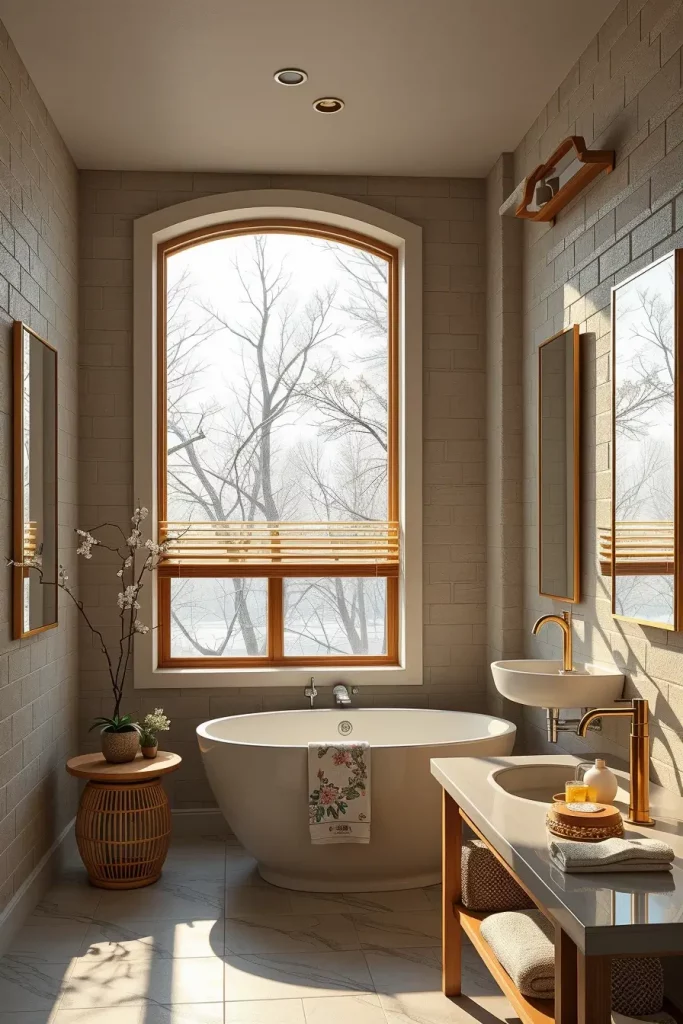
Most of the time, I choose to use privacy glass over a large picture window or I add clerestory windows to the design so the walls don’t feel narrow and there is still sunlight in the room. Choosing texture with glass or wood slats is a solution for those concerned with privacy. The window coverings such as linen or bamboo, are not thick, so the feeling of airiness can be kept. Light is reflected throughout the space using mirrors which opens up the area even more.
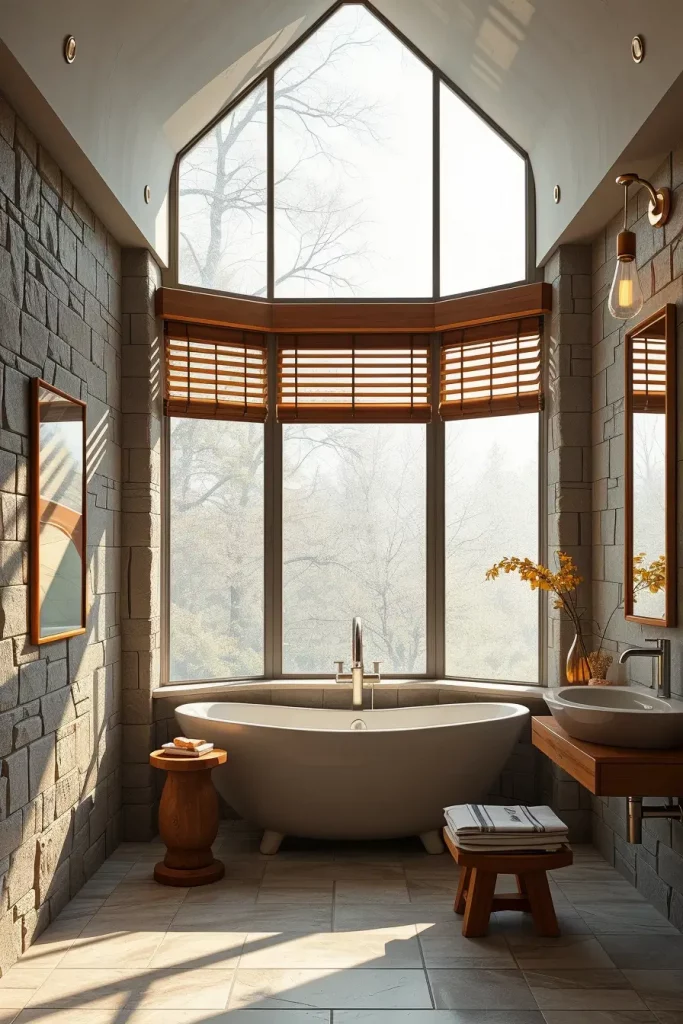
Bathrooms that let in lots of natural light look and feel much more luxurious, even when they are not very big. Architectural Digest noted that using light in Japandi style leads to emotional simplicity which is why I often recommend it for bathrooms.
You could add a little window between the bathroom and another private space to give the house more natural light and keep the spaces connected.
Neutral Color Palettes For A Calm Bathroom Atmosphere
Japandi designs in bathrooms often use mild, neutral colors. To me, having warm beige, soft grey, greige and off-white colors in a room helps me relax. They keep the space calm and allow the materials, shapes and lighting to be noticed. I consider it a good idea to work with only a few colors so everything feels connected.

Matte white walls look good paired with taupe tiles or pale wooden cabinets. Little touches such as black fittings or charcoal decorations, are selected to balance the space. On neutral walls, paints with a thick finish and warm earthy colors make the room cozy and I use woven materials and fabrics in similar, soft ones for a touch of comfort.
I have found that bathroom spaces with neutral decor are sustainably on trend. Clients say they feel calm and less excited which is exactly the desired effect. Dwell states that Japandi design for bathrooms includes soft colors that don’t stand out and make the space more comfortable.
When the space is finished, I would ensure that some materials like sinks are glossy, while others like the floor look rough from a distance, to keep the neutral coloring dynamic.
Wooden Accents That Warm Up The Space
A Japandi bathroom needs wood to feel like a true Japandi space. I usually bring in wood elements in my designs, as they help calm and “set the room” within a simple space. Pieces of wood add reference to influences from Japan and Scandinavia, inviting a feeling of closeness to natural surroundings.
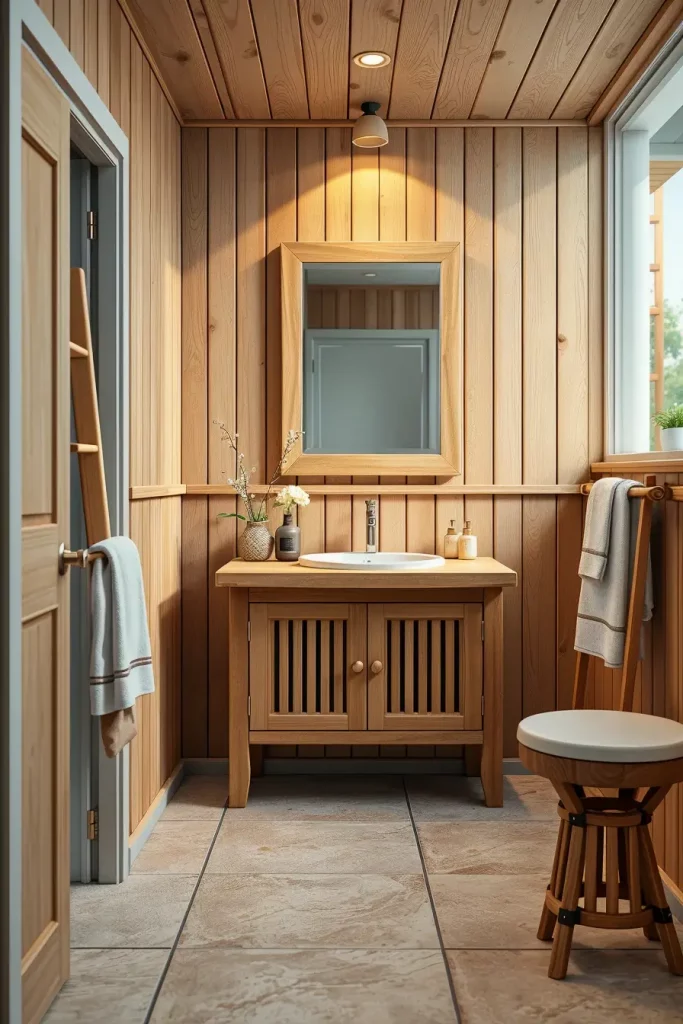
A lot of the time, I make my vanities and open shelves with light oak or ash wood. Japanese bathhouses usually use cedar which is known for its beauty. Texture and musicality are added to flat walls with wood slats, towel hooks and mirrors. A stool or a tray can easily match and complement the handmade appearance of the furniture.

I think that any wood in a bathroom needs to be properly sealed and set up in a well-thought-out manner. If done the correct way, it gives your clothes distinct softness and personality. Designers at Dezeen have noted that “wood softens the austerity of minimal interiors,” which aligns perfectly with Japandi’s goals.
Another useful idea is to use dark-stained wood or wood that has been charred, since this stands out strongly against light walls or tiles.
Sleek Fixtures With Subtle Japanese Influence
In a Japandi bathroom, the fittings need to have a sleek shape and detailed design. I prefer to pick tapware and fittings that are quiet catches of style. Such fixtures have a slender body, curved lines and a calm metallic look seen in brushed nickel, matte black or bronze.
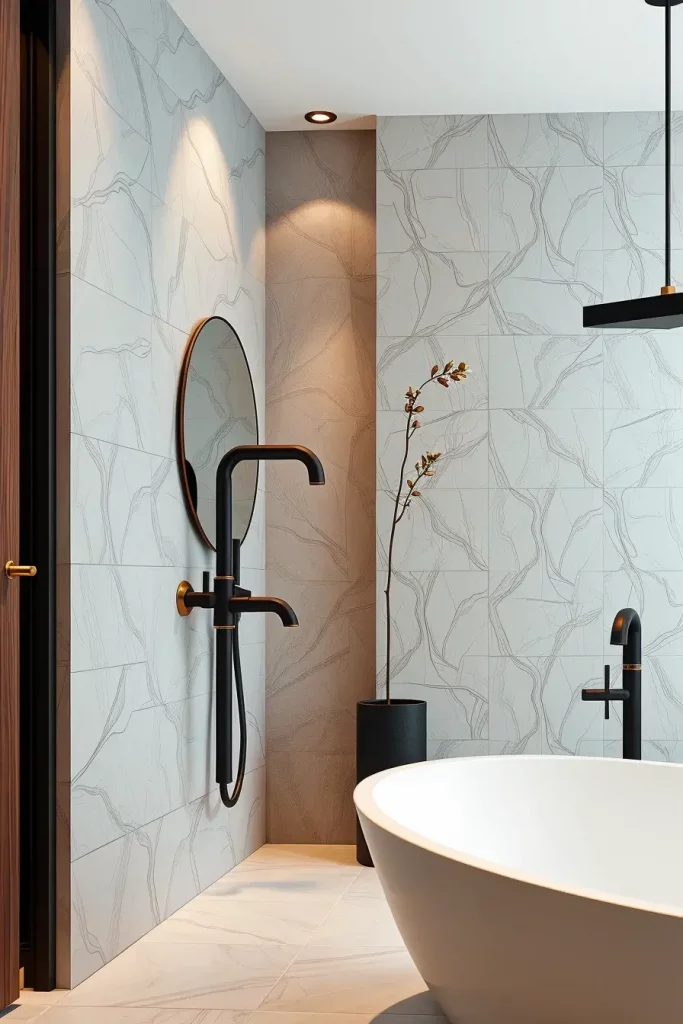
I often put a soft-edged square sink with a slim wall-mounted faucet. Sleek and basic freestanding bath faucets are another design I really enjoy. All the fixtures need to look right, both in how they are mounted and how they look in the space. Handle-less faucets, hidden cisterns and flush plate toilets give the bathroom its modern design.
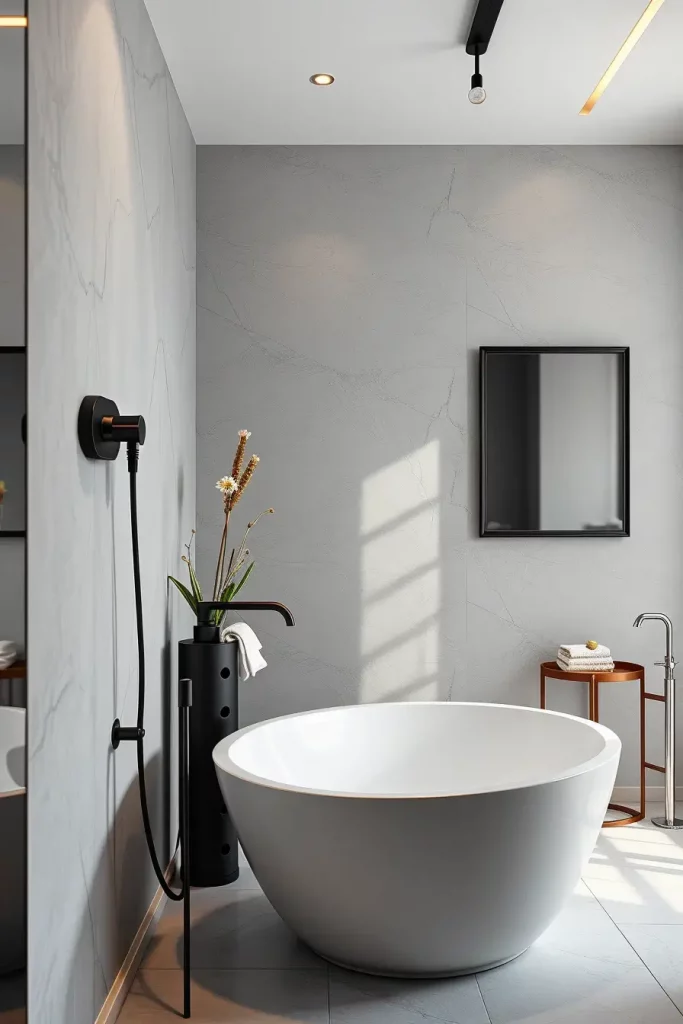
Living within limits is a good way to experience luxury. House Beautiful magazine mentions that well-designed Japandi bathrooms are “built without elaborate designs and stay simple.” I totally agree with you, mainly when we look at fixtures.
Japanese water controls or having a bidet mode could be a useful addition in any bathroom.
Stone And Concrete Textures For Modern Tranquility
Stone and concrete are main features in Japandi design, giving the bathroom a calming effect. I like using tumbled stone tiles, terrazzo and polished concrete since they create a little pattern that is not too obvious.

Large tiles in stone or concrete are my regular choice for both floors and walls to create a smooth-flowing look. I often use concrete to make basins and countertops which look great when paired with wood. Little decorations, for example, soap dishes or ceramic/stone hooks, can complete the look of the whole space.
From what I have seen, the contrast of raw stone and fine concrete fits perfectly in Japandi designs. Domino Magazine reports that these materials “give a natural sense of modern style to any room by adding depth and texture.”
Looking ahead, I suggest using a stone feature wall or add pebbles to the shower floor to underline the sensory appeal and help maintain the natural feeling in the bathroom.
Floating Vanities With Clean, Linear Profiles
I enjoy adding floating vanities whenever I can in a Japandi bathroom design. Because of their straight shape and being attached to the wall, they give an up-to-date look and allow people to enjoy more floor space and brighter rooms.

Most of the time, I suggest having a wooden walnut or oak vanity with big drawers hidden inside for easy storage. The unit should fit inside the basin or stay as a separate vessel above it. The simplest setup is with few or no hardware devices possible. Undercabinet LED strip lighting will make the furniture appear as if it is floating and give the space a pleasant glow.
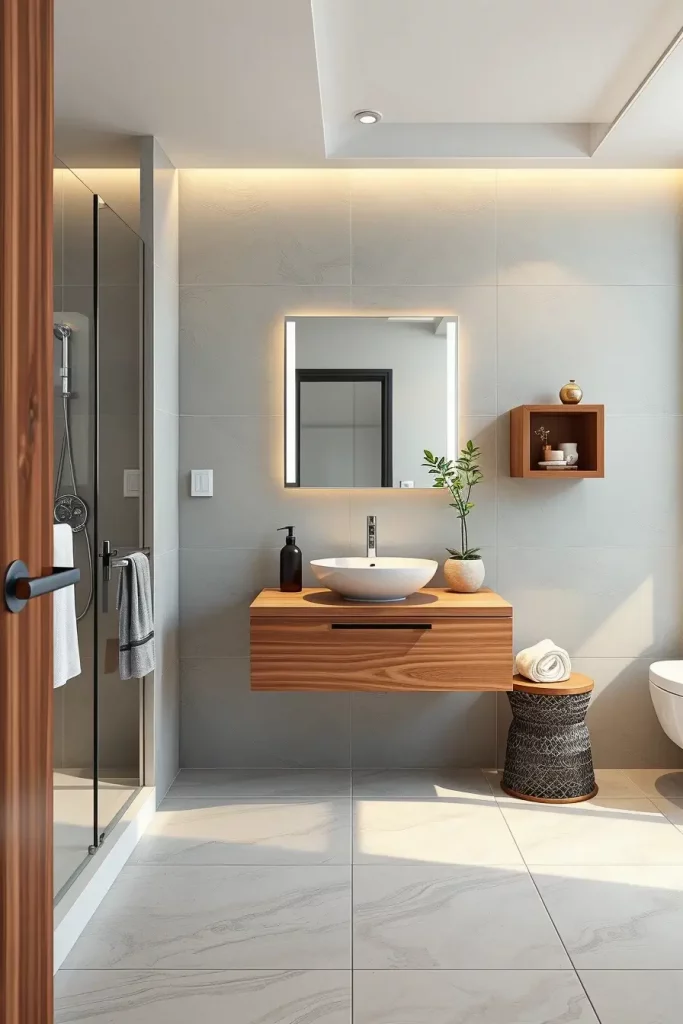
Many clients mention that having this arrangement turns their bathroom into a spa-like room. Japandi design is also in line with what Better Homes & Gardens said recently: the idea is that everything in a Japandi room has a purpose and a place.
Should I want to improve this room further, I would install a mirror cabinet on the wall to hide additional things which would also match the woodboard to tie it all together.
Freestanding Soaking Tubs With Zen Appeal
Ordinarily, a freestanding soaking tub represents luxury in any bathroom, but in Japandi style, it becomes an important part of relaxation. I commonly put the tub just opposite a window with a bright natural light or arrange it with some wooden or stone decor to evoke a spa feeling. Choose a design that is straightforward, sculptural and centered so you can relax here.

I typically pick oval or rectangular freestanding tubs finished in matte white or light stone. More impressive models have narrow edges and deep tubs which is comfortable for long baths. Faucets installed on the floor look great when they are simple black- or brushed-metal designs. I often put a small wooden stool or a ceramic tray in the tub so I have a place to keep bath salts and candles close by.
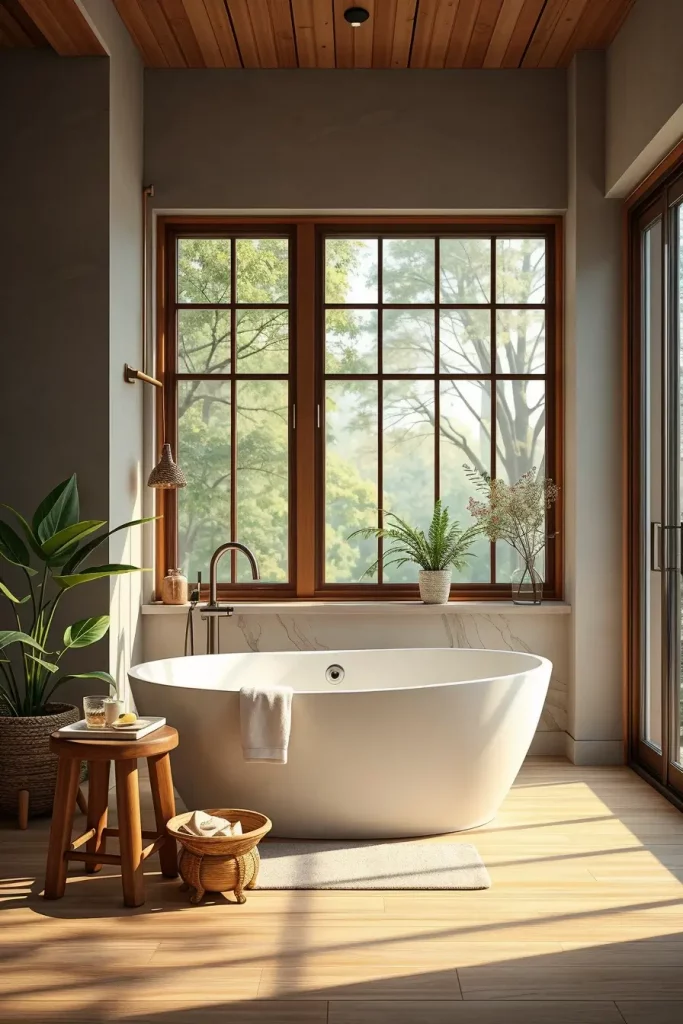
Using a soaking tub has helped me appreciate bathing time which is a key principle in the Japandi style. According to Architectural Digest, Japanese bathrooms focus on water’s healing effects which is shown in the placement and shape of the tub.
Another way to improve this is to Create an area around the tub with raised pebbles or completed with a wood items, bringing in even more of the natural feeling.
Walk-In Showers Framed In Simplicity
Japandi bathrooms often have walk-in showers, since they focus on functionality and avoiding any obstructions. All these spaces are composed for seamlessness—it’s all open, done without steps or visually broken. Frameless glass panels are necessary because they help the design look open and give a clear view. Make sure your home layout calms you, not confuses you.

I often use tiles in light shades of beige, light gray or stone, together with linear drains to give a simple and smooth look. Having a bench or niche already built in the design is practical and looks balanced. Pick slim and subtle shower fittings, preferably matte black, chrome or brushed brass and choose ones with gentle curves.
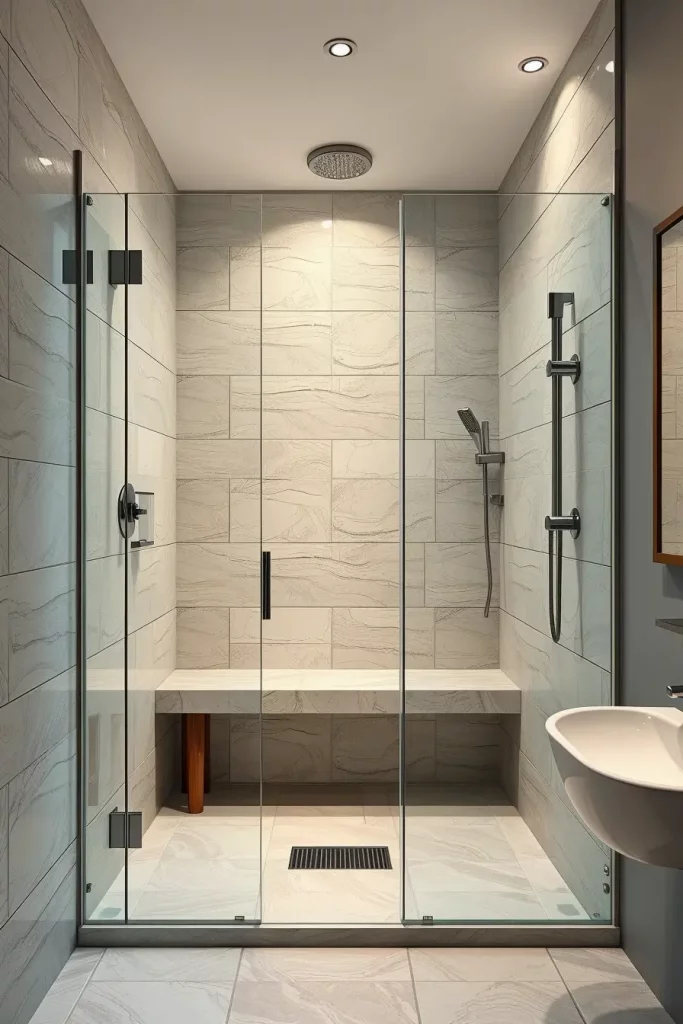
Many clients have improved their bathrooms by changing to a walk-in layout. It invites people to practice mindfulness in their ordinary moments. Domino Magazine explained that Japandi design focuses on how use and form fit together which is necessary in the relaxed setting of a shower.
I think the one decoration that could make a difference is a flat rainfall showerhead on the ceiling. It enhances the spa environment without making things complicated.
Open Shelving For Minimalist Storage Solutions
Make sure storage in your Japandi bathroom is connected with and complements the design of the room. I usually advise clients who want easy access to choose open shelves. Because they’re not bulky, open shelves make you aware to be intentional with what you keep and how to keep it looking nice.
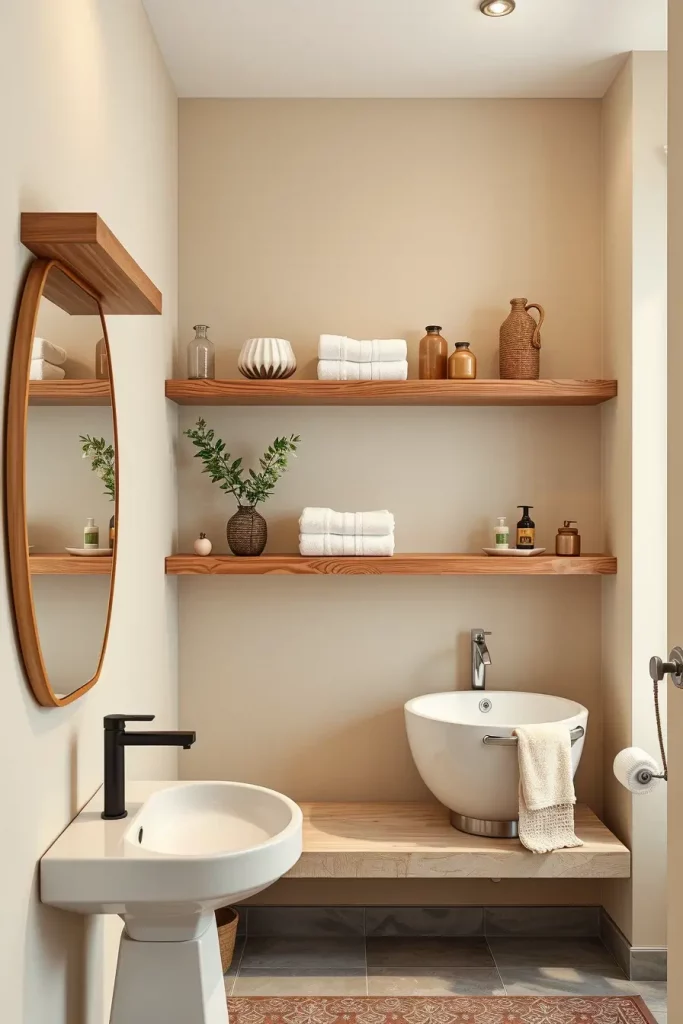
Usually, I install floating shelves above the toilet or alternatively beside the vanity. Light-shade oak or walnut works perfectly, especially when teamed with textured baskets, folded linen towels or ceramic jars. They create a subtle difference in terms of color without becoming too busy. A minimal approach usually works well.
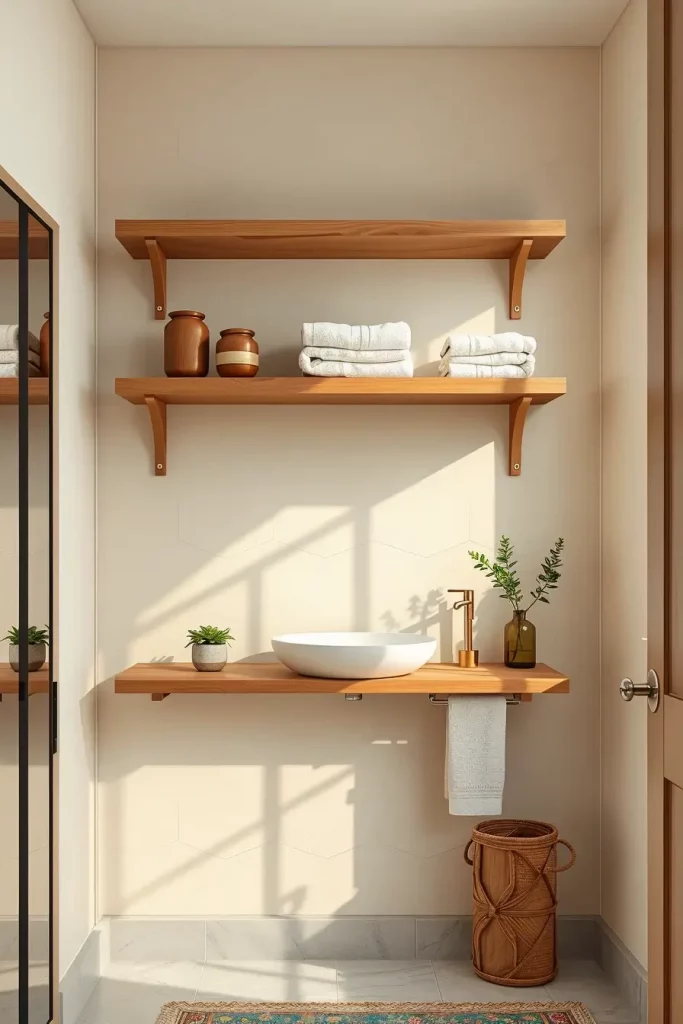
Most people are concerned about keeping things tidy in their open shelving, but the right arrangement can encourage you to keep everything in order. According to Better Homes & Gardens, Japandi bathrooms are designed to promote calm living and better mental health and well-planned storage is important for this.
Essentially, this setup needs a lower wood bench with an open cubby or two which gives you a place to sit and keep some items stored at the same time.
Organic Materials For Natural Japandi Touch
Organic materials are something I always stress in Japandi style. They help the space look solid, peaceful and genuine. To achieve Japandi style in the bathroom, wood, stone, ceramic, linen and rattan are usually used and placed together to bring nature-inspiration and encourage us to interact with them.
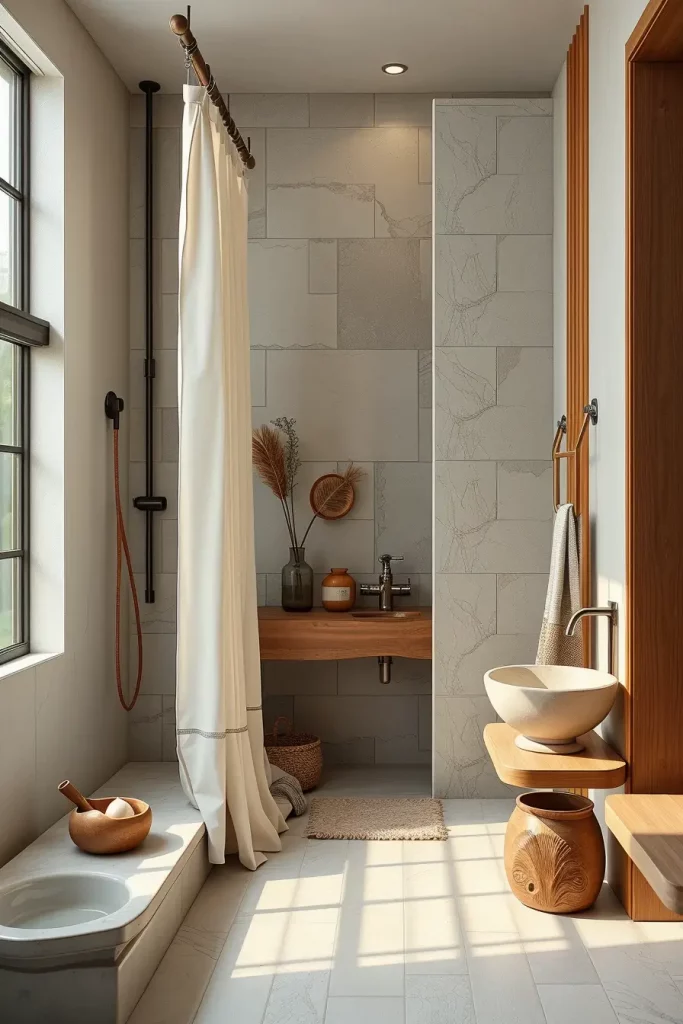
My choice includes products like a ceramic soap dish, handworked trays, wood-based bath rugs or shower curtains made with natural linen. Limewash and plaster on the walls can give a neutral color extra depth and warmth. Use each material selectively, so each item brought in fits the space well.
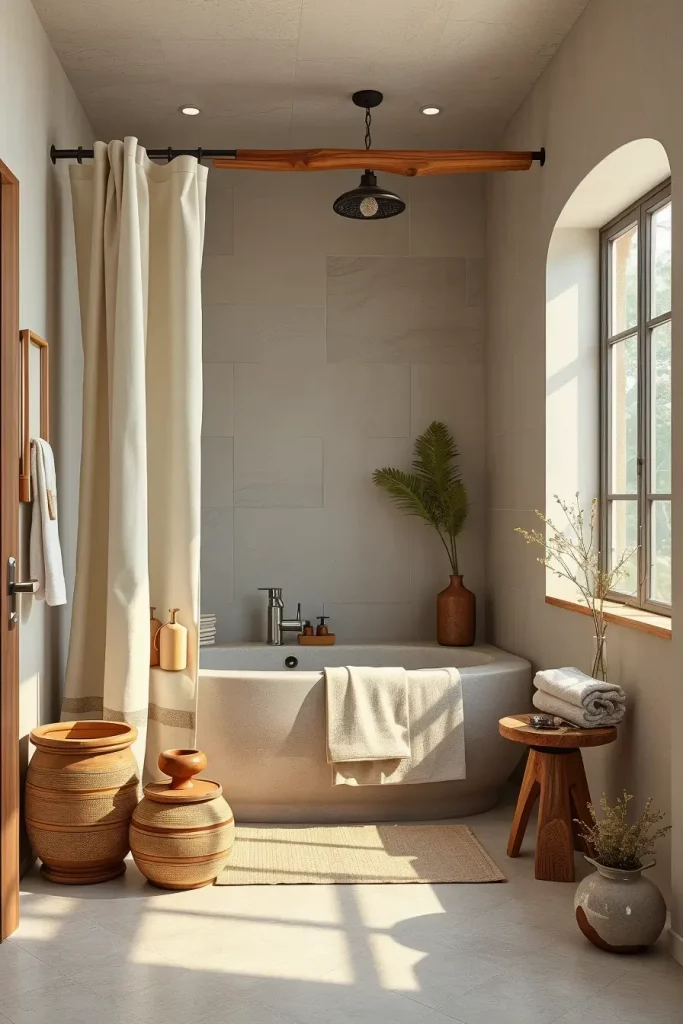
In my experience, the fine details are usually what makes clients most satisfied. They make plain, fancy bathrooms so comfortable you feel like spending time there. Dwell says that Japandi connects structure and practicality with a sense of natural living and that’s done through what we select for spaces.
I suggest also including handmade accessories such as stoneware trays or wall hooks made from clay, to finish this area. The warmth and personality from these pieces fill the room when added.
Using Tatami-Inspired Mats And Accessories
Adding tatami-like materials can bring beauty and sophistication and tatami-style accessories can help balance the design in your Japandi bathroom. Traditional tatami doesn’t work well in wet areas, but the feeling and appearance can be brought into wet spaces with new, water-resistant materials.
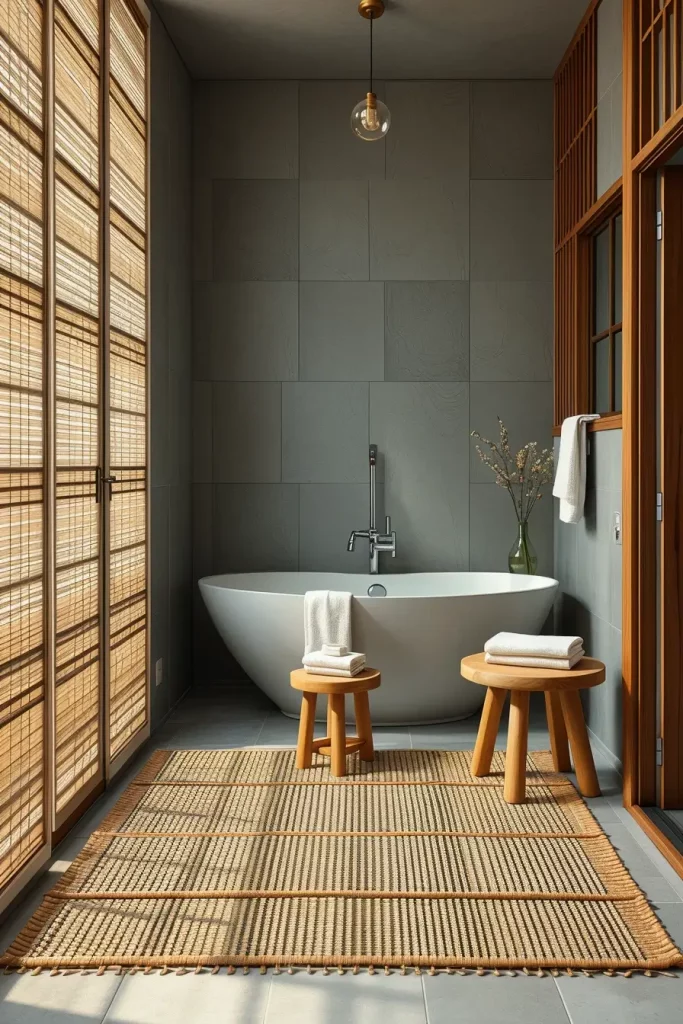
My bath mats usually have weaved textures such as ones that look like rice-straw and bamboo. They let you touch something Japanese without forfeiting use. In certain spaces, I put in foldable seats, floor cushions or decorative woven panels made like tatami layouts to bring the design together.
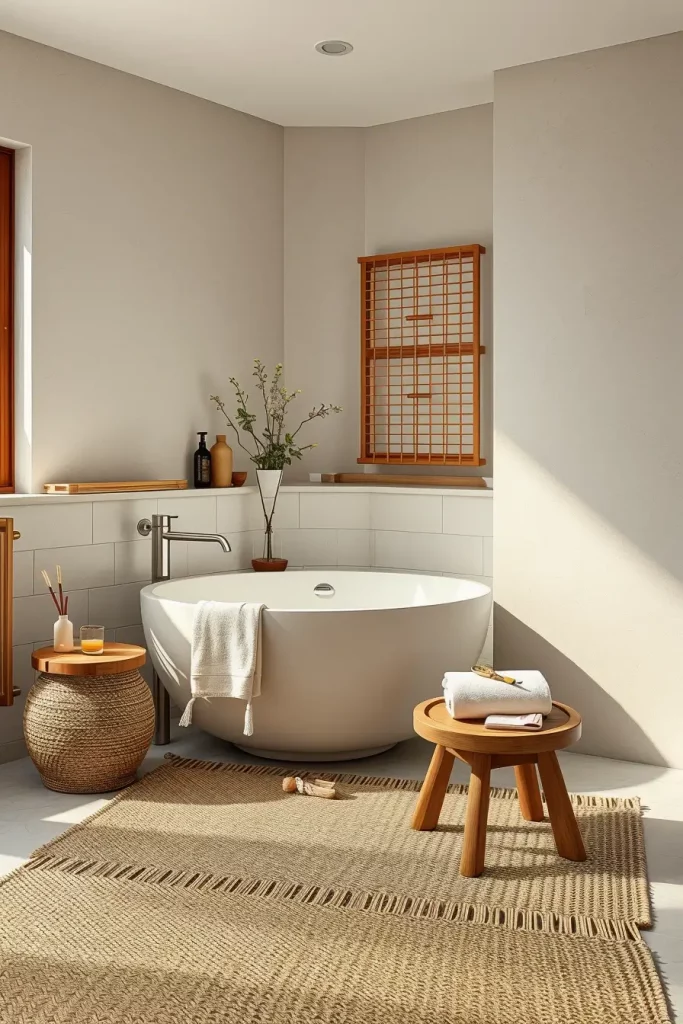
I like this mixing because the anime still keeps true to the original, but with new interpretations. Elle Decor brought up that Japandi values “referencing” culture instead of “copying,” and this is especially important when tatami is used.
To give it a true Japandi feel, I would think about getting a tatami-inspired bench or storage tray which are useful and representative of the design style.
Elegant Simplicity In Japandi Lighting Fixtures
Lighting is very important in a Japandi bathroom design. It ought to look comfortable, useful and interesting as if it was sculpted. I tend to choose lighting that fits well with the overall look and doesn’t take over. The aim is to make the lighting soft and beautiful which encourages comfort.

Among all kinds of sconces, wall-mounted ones made with frosted glass are my favorite. Pops of Japanese culture come from pendant lights with paper or ceramic shades and recessed or strip fixtures underneath cabinets provide soft, clean lighting. Matte instead of glossy and warm, are the best qualities for the finish.

In many of my projects, it is simply the right lighting that really completes the design. House & Garden states that Japandi lighting ought to look integrated into the design which is always how I see it.
Don’t forget to add a way to dim the lights or plan several layers of lighting so you can set the mood whether early in the morning or later in the evening.
Choosing The Right Japandi Bathroom Tile Patterns
I like to begin designing a Japandi bathroom with the tile choice. The usual finishes are matte and natural and the color palette is mostly made up of beige, taupe, dark grays and soft white. I like putting large tiles on the walls and thin planks or mosaics on floors, the way tatami are used in Japanese rooms and smaller slats in Scandinavia. Having tiles with unique texture or slight flaws enhances the look, important in great Japandi design.
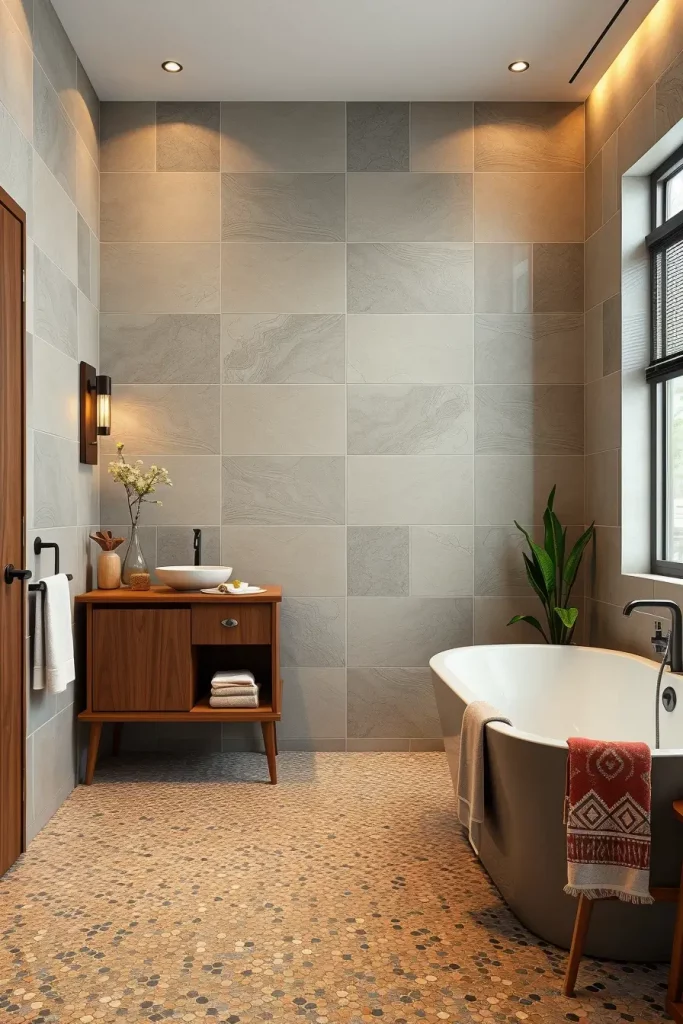
Porcelain or natural stone tiles with a low-sheen appearance such as shades of warm gray or pale sand, are usually what I select. Vertical organization results in clean lines and horizontal setups offer a peaceful feel. Just one accent wall covered with herringbone tile looks great as long as the colors are pleasant together. A wood-type tile next to the tub or vanity brings a Japandi feel to the bathroom without bringing actual wood near water.

In what I’ve seen, homeowners tend to fill their walls, but Japandi design emphasizes simplicity. Most of the time, I suggest clients pick no more than two tile types, for instance a plain base with an attractive accent and avoid the use of vibrant grout colors. People like Amber Lewis state that even in modern, simple styles, adding texture and stone colors to tile helps create a peacefully rich atmosphere.
If I had to include one more thing, I’d suggest in-floor radiant heating could bring more beauty as well as extra comfort to your tiles.
Low-Maintenance Plants To Soften The Space
A Japandi bathroom with a minimalist design still finds a place for green plants. Introducing plants to any space will make hard edges softer, add nature and help maintain the warmth seen in Japanese and Scandinavian homes. When I pick bathroom plants, I go for plants that are easy to maintain and like being in high-humidity—not delicate varieties.
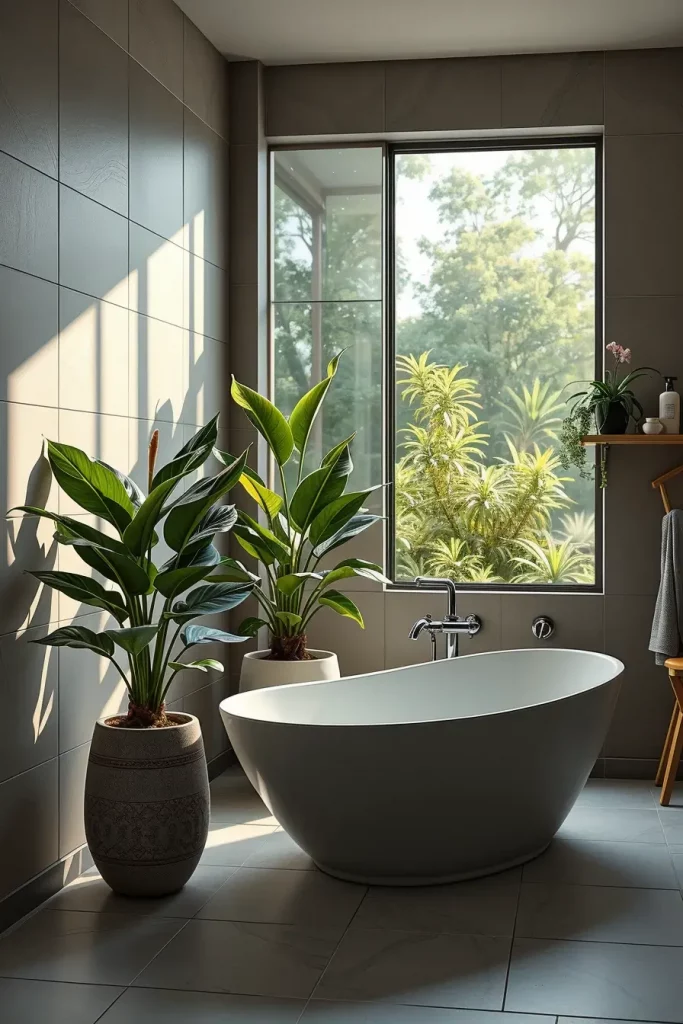
Peace lilies, pothos, rubber plants or ZZ plants are always ones I like, especially if you place the plant in a plain ceramic container. A bamboo stem standing alone in a narrow glass vase by the window may be enough if your bathroom is small. They grow well in a moist spot that gets limited light. Pick containers made from clay or other natural materials in matte or textured designs to fit the Japandi feel.
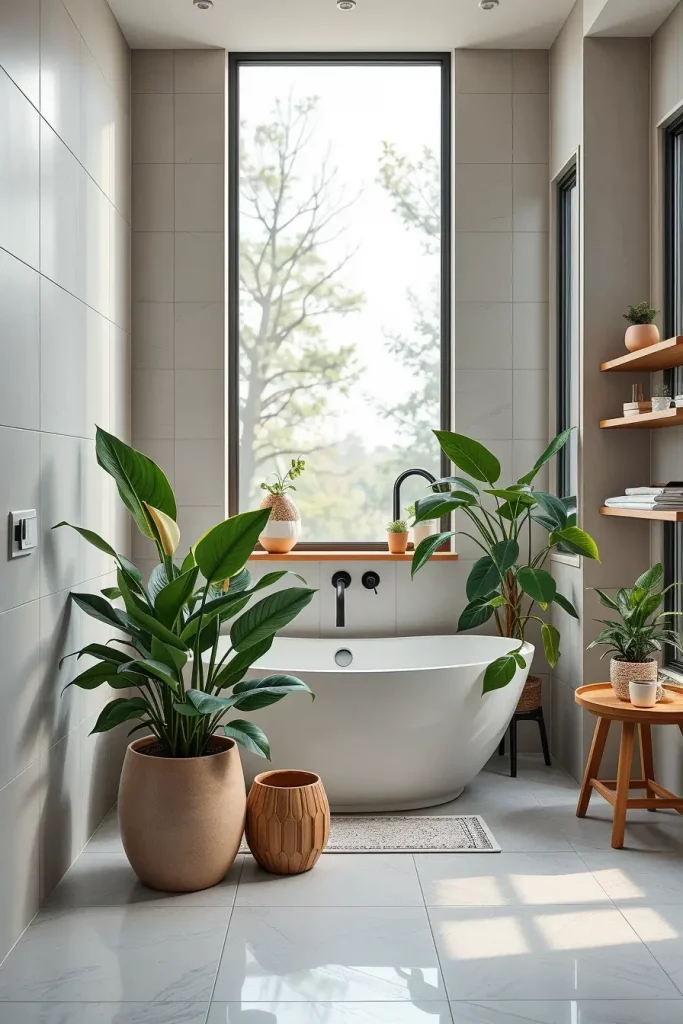
In my projects, I notice that just one correct plant can change the whole feel of a Japandi room. Another customer placed a monstera next to their freestanding tub in one corner and it made the space more interesting. Architectural Digest says that including greenery inside helps people relax which fits with the serenity Japandi tries to bring.
A plant holder affixed to the wall in a wood or brass color could be added to this part. It brings interest to the room but avoids making the floor area too congested.
Subdued Artwork That Reflects Nature And Balance
Any artwork in a Japandi-style bathroom should fit the style and never draw all the attention. I make sure that the colors and lines in the artwork go well with those in the space. When I buy art, I usually go for pieces that feature nature, movement or meditation and they are usually presented in black and white or earth colors. You can use frames with rice-paper prints,, brushwork or ink washes which will look lovely.
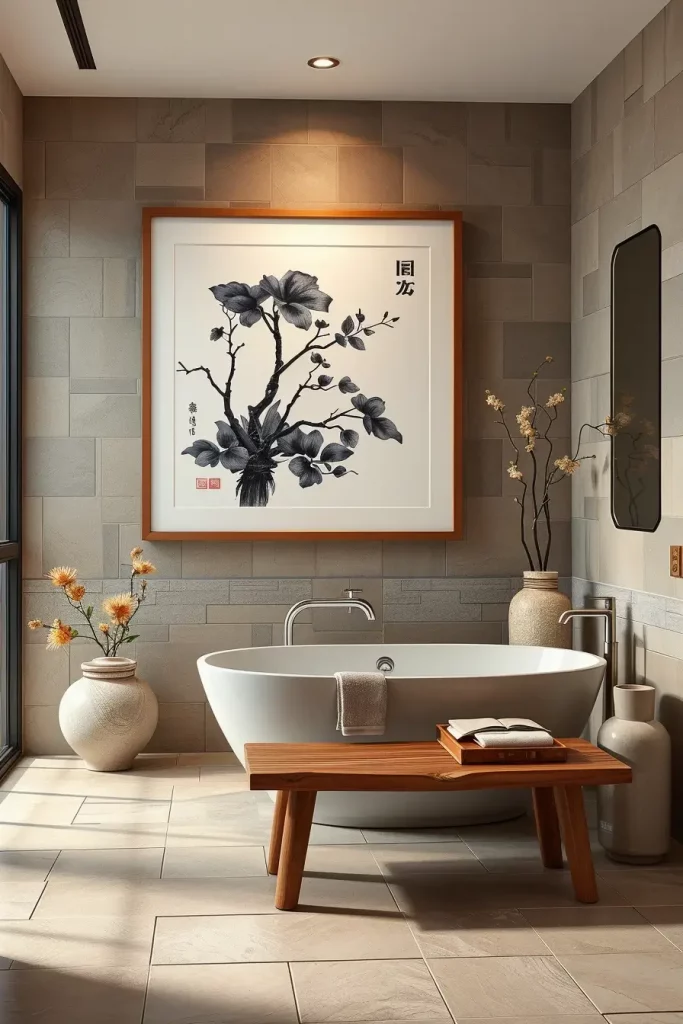
Often, a vertical art piece is hung above a bench, near the vanity or above the bathtub. My frames are usually made of wood, black or soft gold, again depending on the other colors in the space. The artwork needs to look as if it belongs to the architecture, not like something that was built afterward. Themes of rocks, mountains, leaves or waves can help make your designs feel similar to Japanese art and keep the nature theme intact.

Many clients are not aware at first about how important artwork is for bathrooms. Adding a calm painting often restores the emotional harmony of a room. Dwell Magazine points out that Japandi is powerful because it shows emotion through simplicity and artwork follows this approach.
A main point that often gets left out here is lighting. A picture light in bronze or matte black above the artwork can enhance the piece of art without feeling too overpowering.
How To Layer Textures In A Japandi Bathroom
texture in this style is always subtle and is meant to enhance interest without adding unnecessary things. Having different textures in a Japandi bathroom helps make the space attractive with fewer colors. Mixing together textures like plaster, wood and linen is something I often do such as putting a simple wood vanity with a lightly-grained grain beside velvety soft linen.

Your base surfaces should be honed stone tiles, stucco, wood and ceramic to start. You may then place woven baskets for towels, a window covering made from linen or gauze and a cotton or bamboo bathroom mat. The materials are each important, but combining them results in a peaceful and deliberate space.

Some may think minimalism makes things dull, but I know adding multiple textures makes the space interesting. Nate Berkus pointed out that texture is important for making a neutral space not boring and Japandi is built around this idea. Making a room appealing isn’t just about furnishing it with many things; it’s about keeping things balanced and different at the same time.
If you wish to add something, how about a handwoven stool or a wooden tray with raw edges which will make the space even more dimensional?
The Role Of Balance And Symmetry In Japandi Layouts
In a Japandi bathroom, the idea is to create an atmosphere of balance. The space must be neither packed with too many things nor sparely decorated, but balanced as you see in nature. Wherever I can, I put the tub in the center of the back wall and have matching bathroom cabinets on each side.
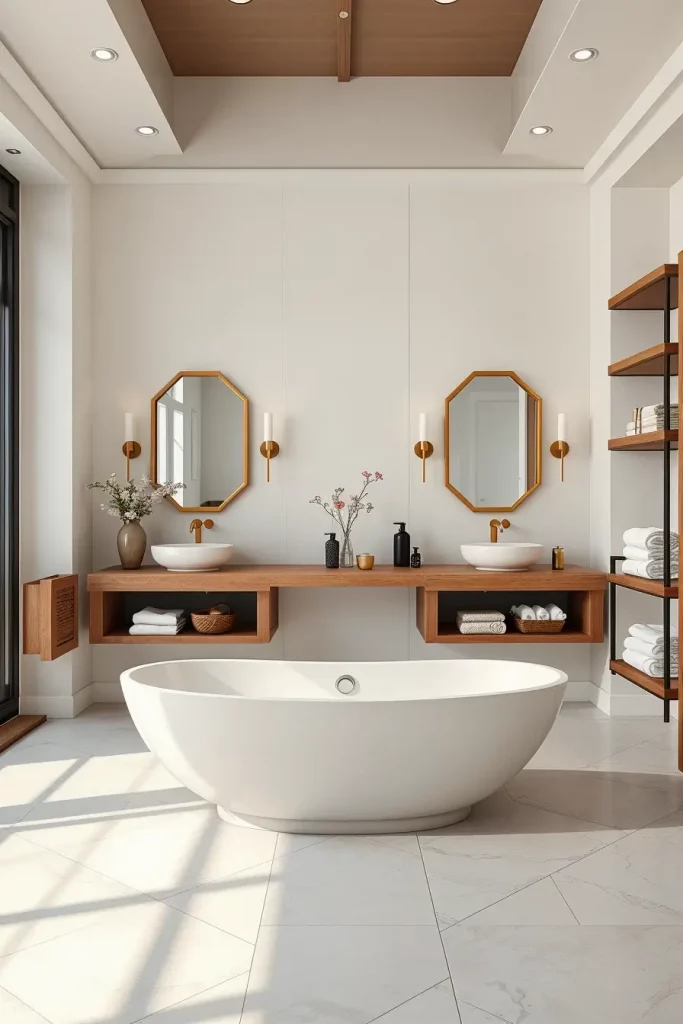
Items in the room such as furniture and fixtures, need to be arranged purposefully and in an uncluttered way. Picking wall-hung vanities, floating benches and centered mirrors allows for easier clean sight lines. Sometimes layout limits us, so I use balance in design and color, for example placing a large tub with a vertical tower of towels on one side and setting a slim wooden shelf against the opposite side.
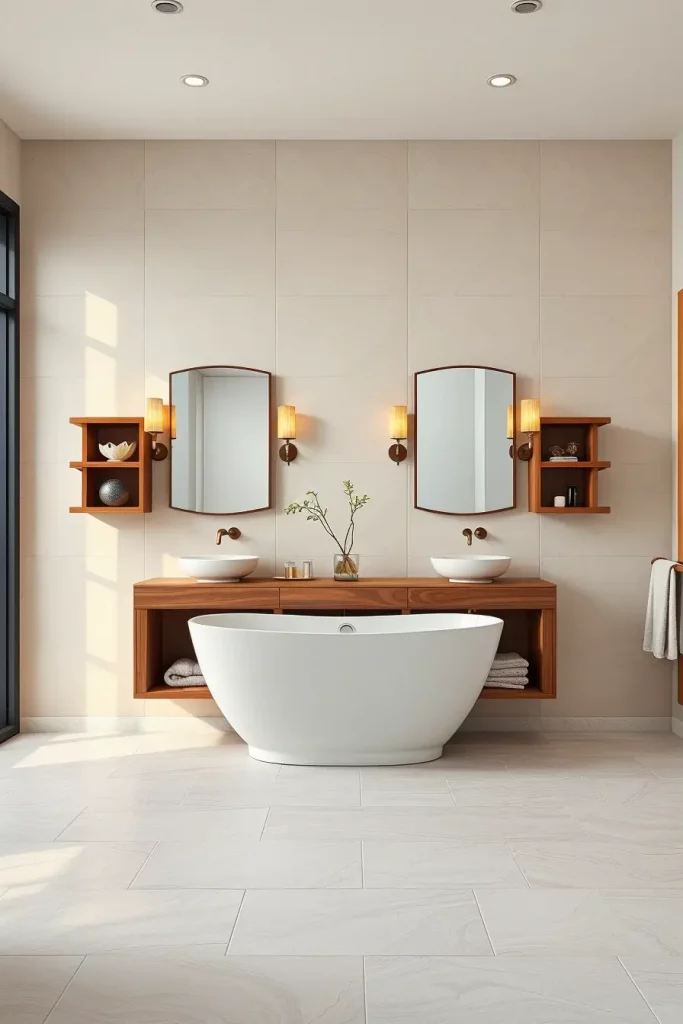
In designing, I usually need to take things away rather than add things. I’ve advised clients to change or get rid of details that create a visual disruption. According to Elle Decor, Japandi style aims for a “still” space and that idea begins with how the space is arranged. A randomly arranged room in no way reflects Japandi.
An extra touch to this part could be details about the height of the ceilings. If the ceilings are relatively low, tall mirrors or hanging lamps will make the room seem balanced by focusing on vertical space.
Curated Decor: Less But Meaningful
Everything in a Japandi bathroom should be picked with care. Instead of placing lots of objects in the space, I pick a few that match the vibe such as a clay vase, a flat stone tray or a candle that was hand poured. Every item should help the room or bring a sense of peace, not only act as a filler.

Most bathrooms are styled with just three to five decorative pieces. Tea light cubes nearby, a bowl for bath salts and a simple carved wood stool can make your space ready. Pick natural materials such as unfinished clay, frosted glass or natural stone and use shapes that are more rounded. Arrange them in groups of three or more if you want the area to look put together.
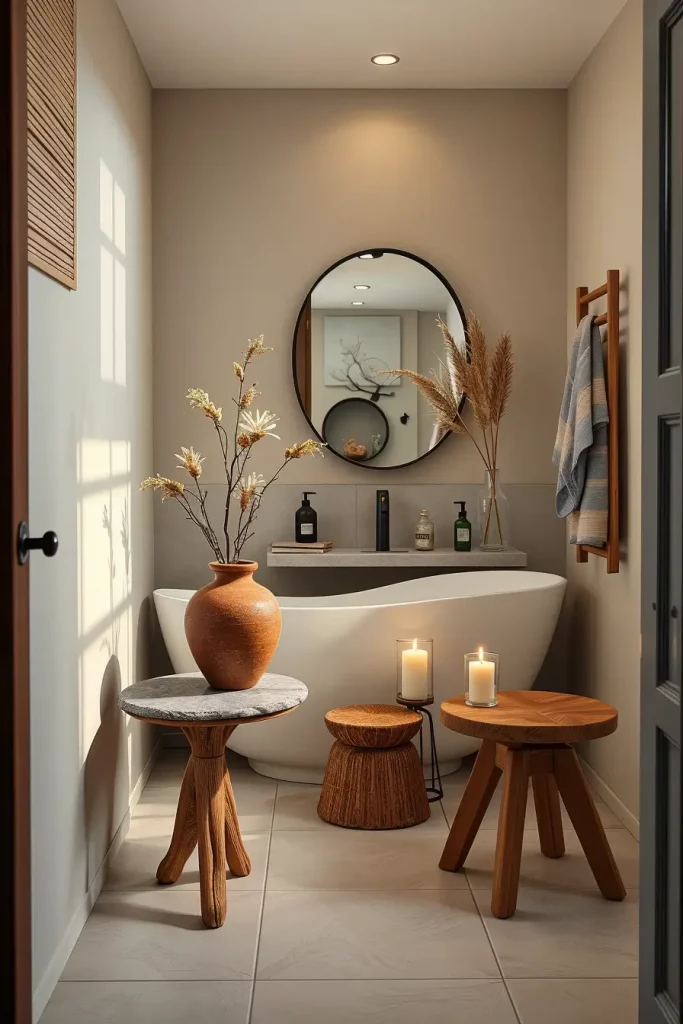
Based on my experiences with clients, I believe that mindful minimalism can be very luxurious. A family living small exchanged a large stock of products for a few basic items and said they felt happier every day. Japandi design follows a “quiet quality” approach and that includes the things we put in our homes.
To increase the usefulness of these rooms, I like the look of built-in niches for putting small objects. It ensures the cookware is well integrated with the counters and does not add to counter clutter.
Soft Towels And Linen Fabrics In Neutral Shades
A Japandi bathroom is not finished without including soft linens. Having towels, robes and curtain in plain colors like ecru, gray or oatmeal makes the space feel calmer. I choose Turkish or Japanese cotton for towels and always advise using linen or gauze for curtains or window covers because of their natural way of dropping down and breathability.
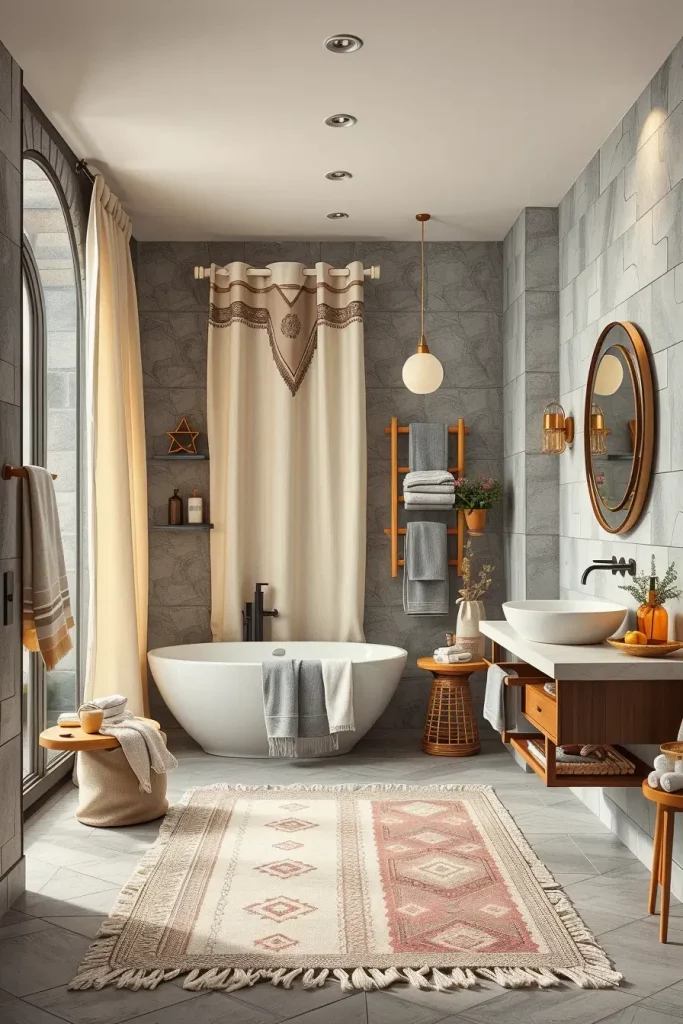
Pick whites, grays and warm beige colors and stay away from bold patterns. Having one large waffle-texture towel can help create contrast, but it won’t seem too overwhelming in the room. Put a hand towel on top of a bath towel that is hanging on a wooden ladder or peg hook for a nice yet casual appearance.

To me, clients usually pay attention to linen details only after feeling how much better it can be. Moving to softer, natural materials is often one of the changes they love most. House Beautiful notes that Japandi focuses on texture and high quality and bath linens are a smart way to display this.
Placing a built-in linen shelf or wooden bench with folded towels here can make this section feel better organized. Designers use sleek and luxury styles, but keep the essence of Japandi.
Subtle Scents With Natural Aroma Diffusers
An ideal Japandi-style bathroom will engage the senses and scent should be one of them. That is why I think using natural aroma diffusers can delicately make you feel better. In this design style, artificial air fresheners seem wrong; however, natural oils such as cedarwood, lavender or yuzu feel just right because they are calming. They help the space feel peaceful and focus your mind which is important in both Japanese and Scandinavian ways of life.
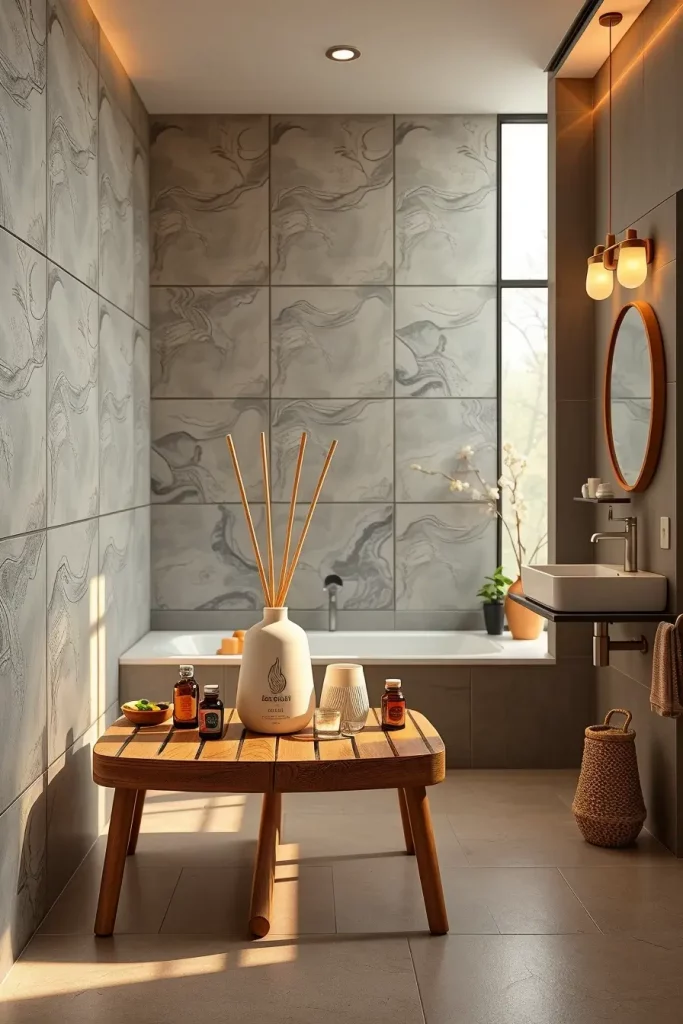
I prefer ceramic reed diffusers or small stone or wood electric diffusers. Their aroma should be mild and they should match their surroundings rather than be seen as attention-grabbers. I normally put them just by the tub or on a wooden bench so the scent is gentle and soft. An amber-bottled essential oil blend seems real and keeps your bathroom free from any synthetic smells.
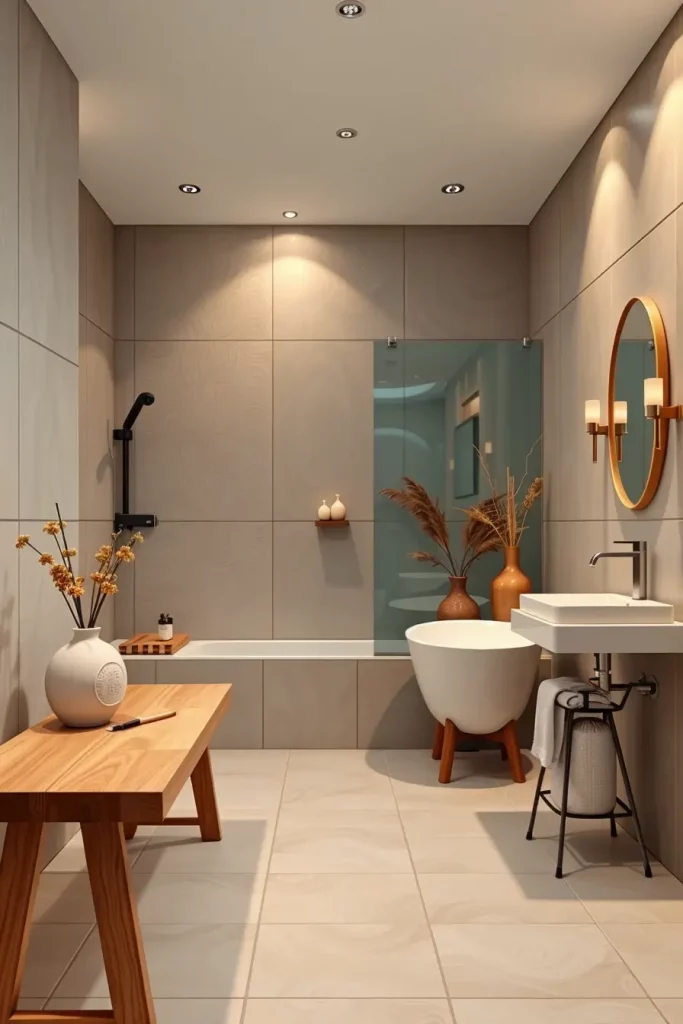
When I’m designing or using any products, I believe that scent is often what makes everything feel cohesive. Those who were hesitant at the start say they enjoy bathroom time more after fragrances are put in the bathroom. The Better Homes & Gardens team points out that using natural fragrances makes a house feel emotionally warmer without adding visual noise.
A good finishing touch for this section would be to allot a tray or shelf to store scent tools and you might pair them with a small sponge or some dried herbs for a nice touch of texture.
Mirror Shapes That Echo Japandi Harmony
Bathrooms often place the mirror as a main feature and in Japandi design, it is supposed to fit with the style and work well. Having shapes that are not sharp such as rounded mirrors, circles or ovals, often feels best to me. That focus on calm curves and smooth geometry is what these designs represent in Japandi style.
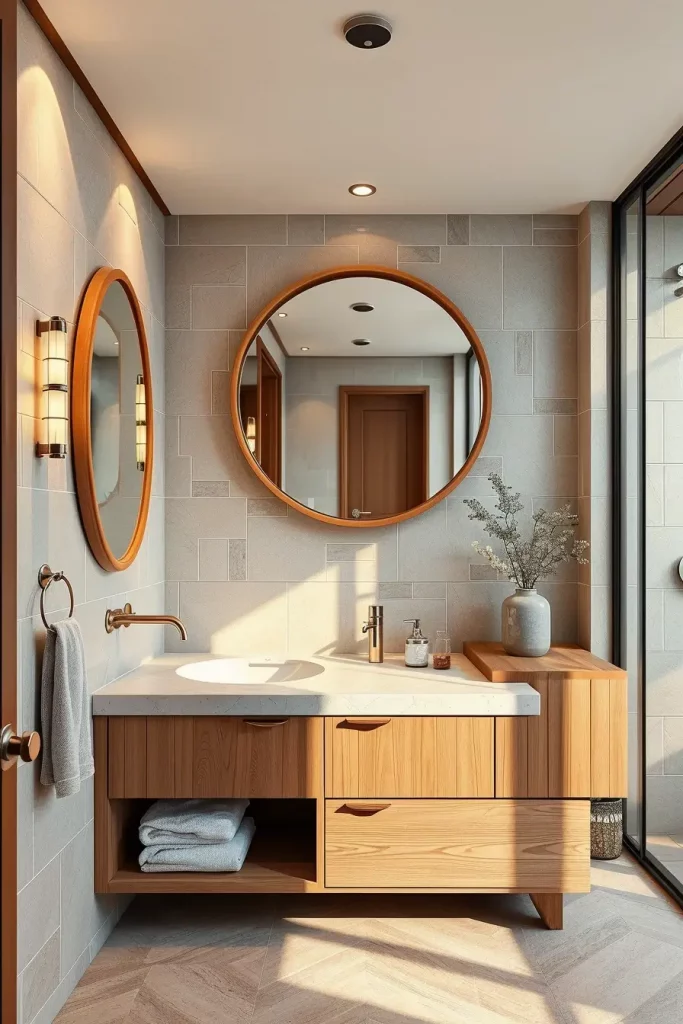
What I like most are mirrors that are frame-free or have super-thin edges of wood or black color. They go well with things such as a wooden vanity and dark metal sconces. Round mirrors with walnut frames are regularly placed above a pale stone sink by me, since this adds character but doesn’t overpower the space. Mirror placement matters and they should be placed where they can reflect light and match with vanities and lights.
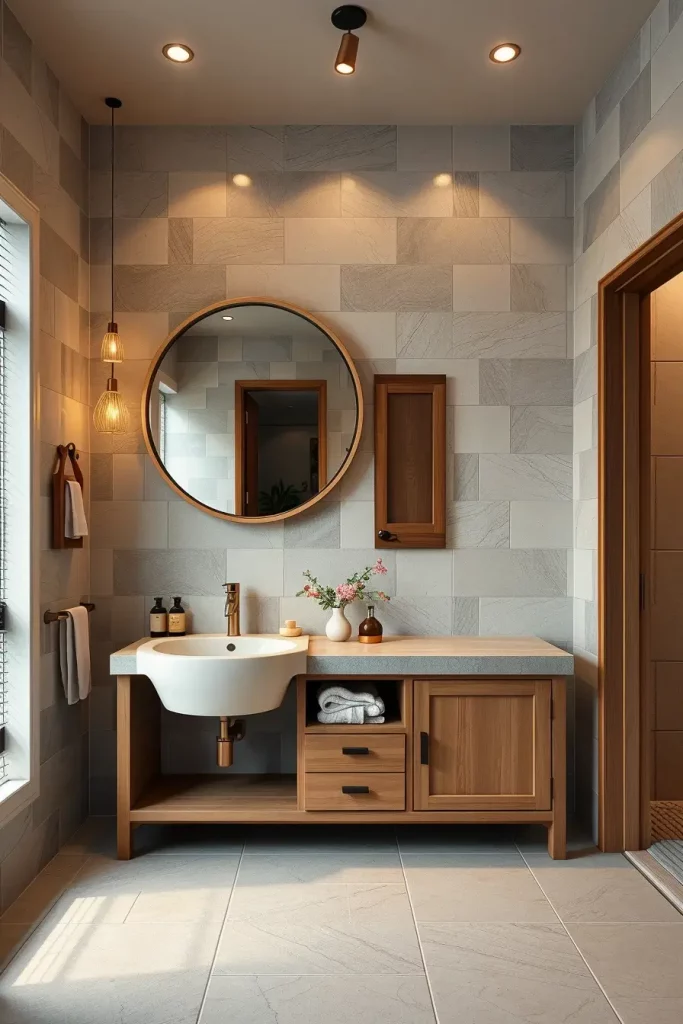
I can certainly say that picking the right mirror can completely change the atmosphere of a room. One client requested an arch-shaped oak mirror instead of her standard rectangular mirror and the room immediately seemed better organized. According to Domino Magazine, including rounded mirrors makes minimalist spaces feel warmer and fits the Japandi style well.
Many people don’t pay attention to how high or low the mirror is placed. The mirror should meet the eye level properly and its spacing from the wall should enable the wall to appear open.
Dual Functionality In Japandi Bathroom Furniture
Having functionality is the main focus of Japandi bathrooms. Therefore, I always make sure to buy furniture that does more than one thing and keeps the space looking light and uncomplicated. Floating sinks, pantries that double as benches and furniture that serves more than one purpose are wonderful ways to save room in a simple, organized house.

Particularly, wall-hung cabinets with push-to-open doors come highly recommended in either pale wood or matte black, according to the needed contrast. Having a freestanding bench near the shower allows you to keep bathroom essentials and also sit down. Also, I’ve chosen hanging towels racks in the shape of a ladder which look stylish and accept numerous items.
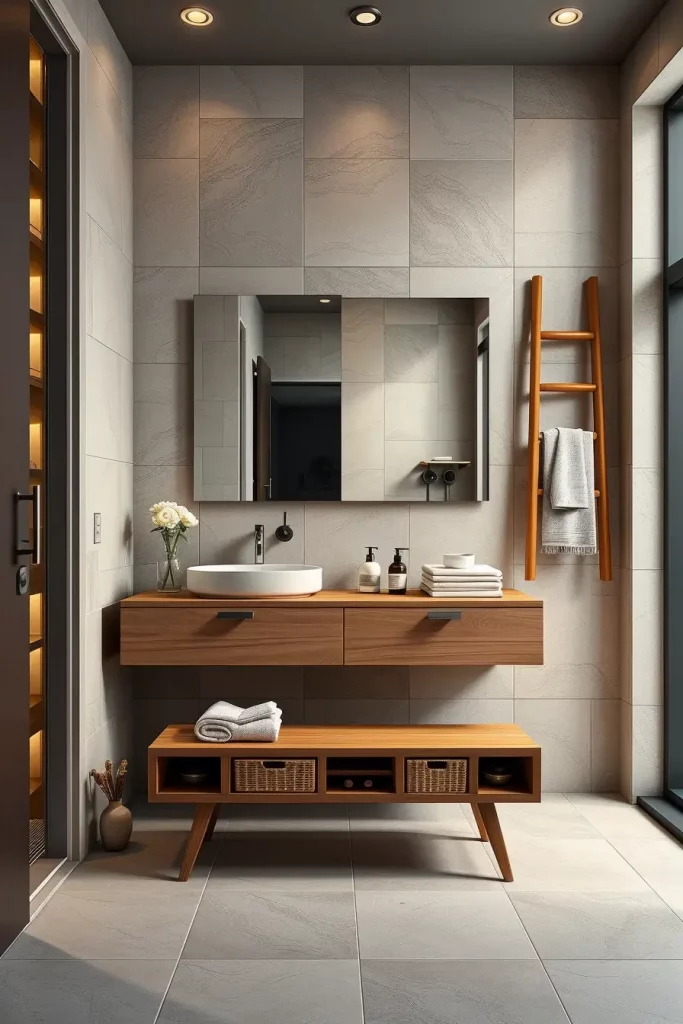
I feel that dual-use products are important to my clients, because they make it easier for their bathrooms to stay uncluttered. In Japandi design, according to Architectural Digest, every thing in the space must be useful and look good. Having pieces that can be used in more than one way adds useability and removes visual distractions.
Mentioning custom or modular cabinets would allow your kitchen space to be configured for you and keep everything looking unified.
Black Accents For Visual Contrast And Depth
The main part of Japandi bathroom is softness, but black highlights are used to ground the space and add depth. Often, I include thin black elements in the kitchen, for example, faucet fixtures, cabinet handles, light sconces or a metal-framed mirror. Because these lines and spaces are small and clean, they add a strong but tidy contrast to the layout.

Using matte black faucets and a matched towel hook brings things together visually. I often prefer to line shower glass with a slender black frame, as it still allows lots of open space while clearly marking out the area. Simultaneously, Japandi interiors get their peaceful character from combining black elements with pale woods and stone.
From my experience, including a strong contrast in bathroom design really supports the overall appearance of the space. A well-known designer from Studio McGee believes that black color helps anchor and steer the design in neutral rooms.
Another useful step is including black in lighting fixtures. Style the room by adding a matte black-colored pendant or wall light to back up the theme and help guide the eye everywhere.
Smart Storage Hidden In Plain Sight
Minimalism requires clean spaces, so in a Japandi bathroom, simply-designed storage should not look like storage. I regularly design spaces by building in hidden cubbyholes, recessed spaces and special built-in drawers. The goal is to bring together visual beauty and usefulness while displaying things like toiletries, linens and accessories.
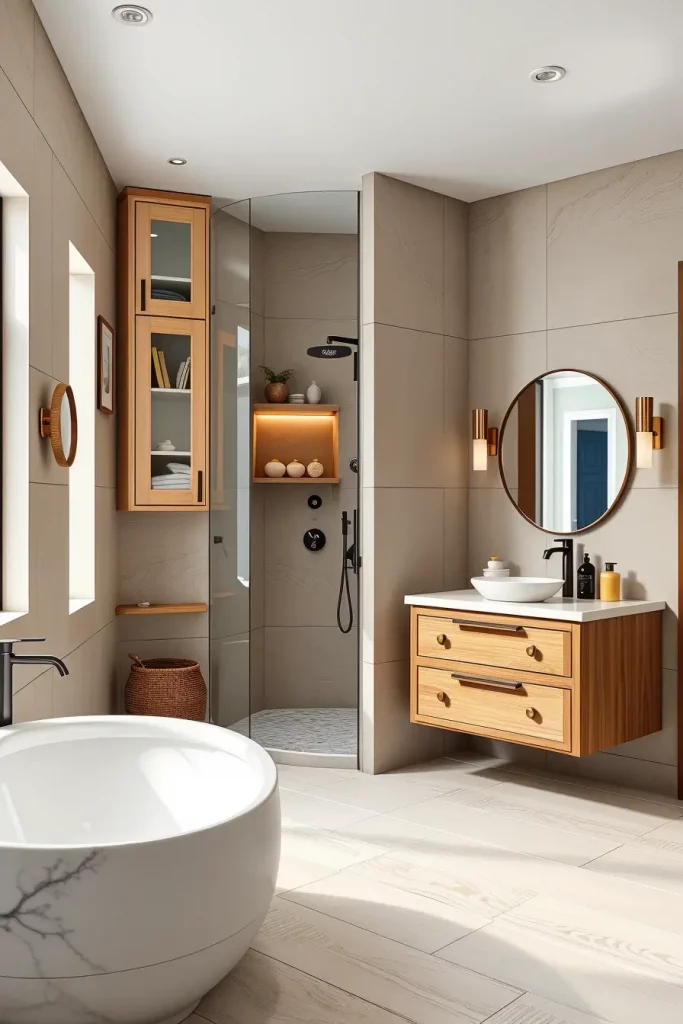
Instead of using counters, choose to keep your shampoo bottles in special built-ins, have personal grooming tools organized in drawers and put a medicine cabinet that works as a mirror in the bathroom. I tend to like floating vanities with drawers that open all the way out — they help the bathroom feel more open and store things effectively. Displaying on open shelving is done only if the items on them are picked with care.
Many clients find they can keep more things organized than they thought. One recent design had a full-length mirror which opened to reveal shelves installed behind it — both functional and attractive. House & Garden calls this “invisible storage,” and it’s a perfect match for Japandi’s understated aesthetic.
You might also want to add custom millwork that coordinates with the walls, so the area for storage looks like it is an extension of the walls.
Emphasizing Quiet Zones And Spa-Like Corners
Putting aside sections in your Japandi bathroom that encourage calm turns the space from practical to relaxing. I make sure to have one area in the room where I can relax, usually beside the bathtub, in front of a window or where there is a bench. There is no need for them to be useful, but they encourage reflection which is important in Japan’s culture and matches Scandinavian beliefs about self-care.

A teak bench covered with folded towels, next to a candle and a ceramic bowl of bath salts looks amazing. A wall ledge of suitable size could be perfect for incense, a diffuser and a hand towel tray. All the colors are low-key, the objects look rounded and smooth and the composition is straightforward. I like gentle light in a kitchen such as sconces that spread the light or hidden LED strips so that no harsh shadows appear.
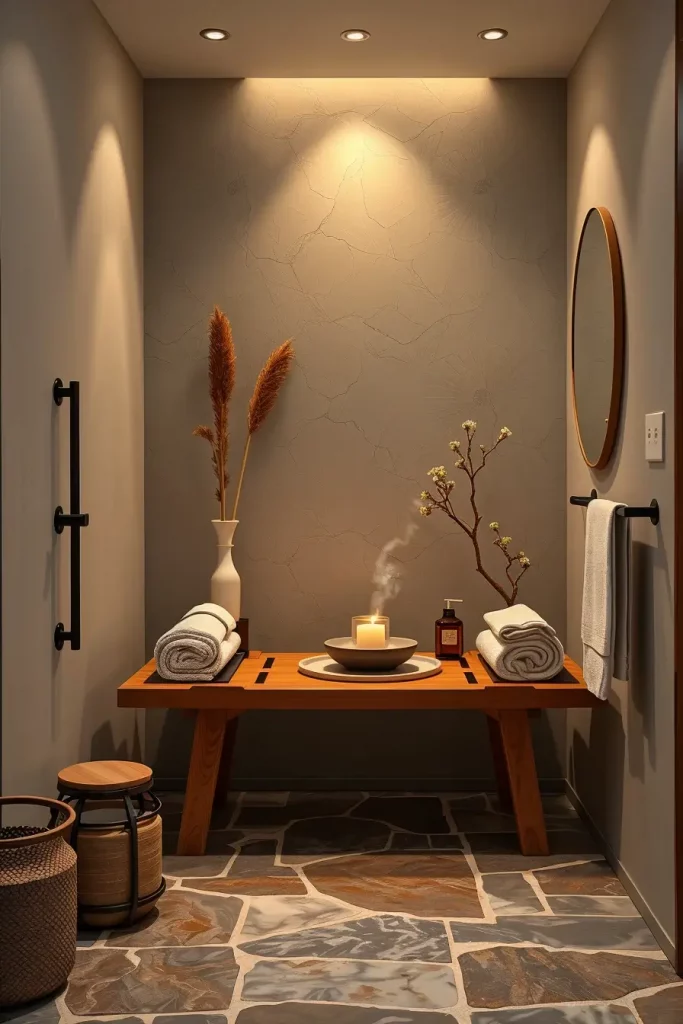
My own bathroom has shown me just how much stopping can help. I put a linen-covered stool and a candle shelf next to the tub and now it’s my favorite place in the house. Well+Good recommends that even just one special ritual in your bathroom can make it more welcome and healthy.
Another idea to strengthen this section is to add a small indoor fountain or stone sound bowl for anyone wanting a multisensory experience.
Japandi Bathroom Inspiration For Small Spaces
Even in small bathrooms, a Japandi design looks great since it relies on being simple and clever. Many times, clients who have bathrooms with unusual shapes ask for a soothing atmosphere. Using modest palettes, ceiling-mounted lighting and thoughtful layouts enables it.

Here, floating vanities make a big difference — they lift the floor to give the room more space. I installed light-colored tiles and a glass shower divider so nothing blocks the view. Function is offered without excessive clutter by using a little mirror, vertical hangers and possibly a bath niche or recessed shelving. You can save space using a sliding door which aligns nicely with the purpose of Japandi design.

Working in tiny powder rooms, even something as simple as putting in a wooden stool and reed diffuser makes it feel cozier and elevated. HGTV notes that great design in small spaces means being intentional and using a minimum number of materials which is exactly what Japandi is about.
I think adding tall mirrors or hanging lights can help lengthen the wall and elevate the space appear bigger.
Large Japandi Bathrooms With Open Layout Ideas
As I design a big Japandi bathroom, I pay attention to creating a spacious design that is visually balanced, calming and practical. The aim is to focus on wood and stone as the main design elements, arranging the space so that it remains organised and bright. With an open space, air circulation and a smooth visual line make the room feel more peaceful, as this is important in Japandi design.
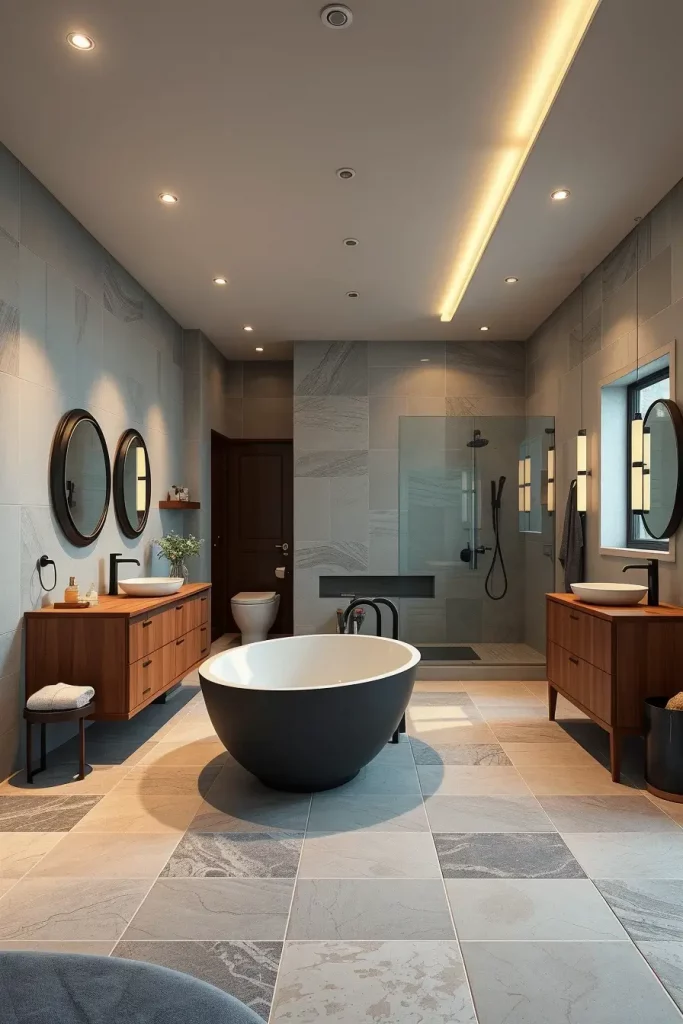
Most often, I install light oak or walnut floating vanities, soaking tubs in a matte-finish white and walk-in showers that have glass walls in these bathrooms. Most of the time, the flooring is made from warm stone or microcement which looks effortlessly connected from room to room. I choose black faucets to contrast the white and put in open wooden shelves for putting up towels or small decorative items. Making all of these choices provides a foundation of grounded, open and peaceful design.
To me, open-plan Japandi bathrooms give the perfect chance to turn our bathroom into a makeshift home spa. They make people feel calm, help them keep things tidy and link nature with their homes. As Architectural Digest points out, setting up a Japandi bathroom with openness and natural materials can help with your mental well-being which I have experienced as well.
Adding a little bit of light behind the mirror or beneath the vanity would further improve the area. How the place is lit really sets the mood for comfort and modern charm.
Creating A Japandi Powder Room With Personality
Creating a Japandi-style powder room is about giving character to the tiny space without making it feel overloaded. To me, these rooms are a great way to enjoy the fundamentals—restrained colors, true textures and crafted bits. Even though it’s small, the Japandi powder room can still be one of the most character-rich spaces in your home.
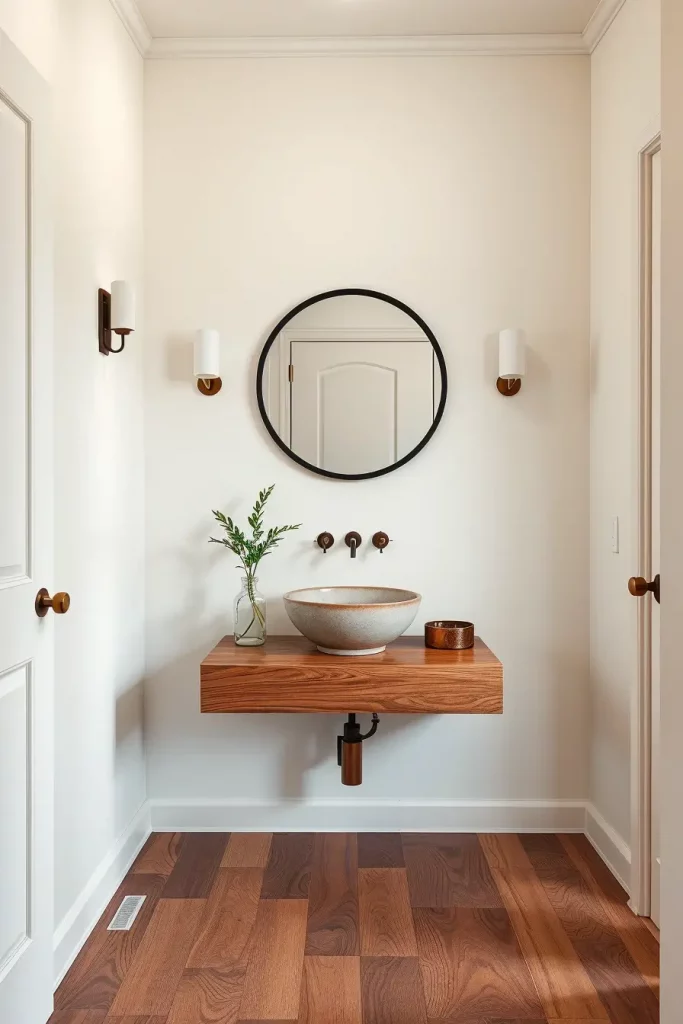
I usually begin with a wooden vanity that’s suspended from the wall and a sink in stone or concrete. The ceiling above holds a round mirror set in a thin black metal frame and the walls are painted with smooth, earthy limewash. For a stylish finish, I put up ceramic wall sconces, handmade accessories and a simple plant. Herringbone wood or polished stone flooring can be used, depending on what fits best within the budget and this environment.
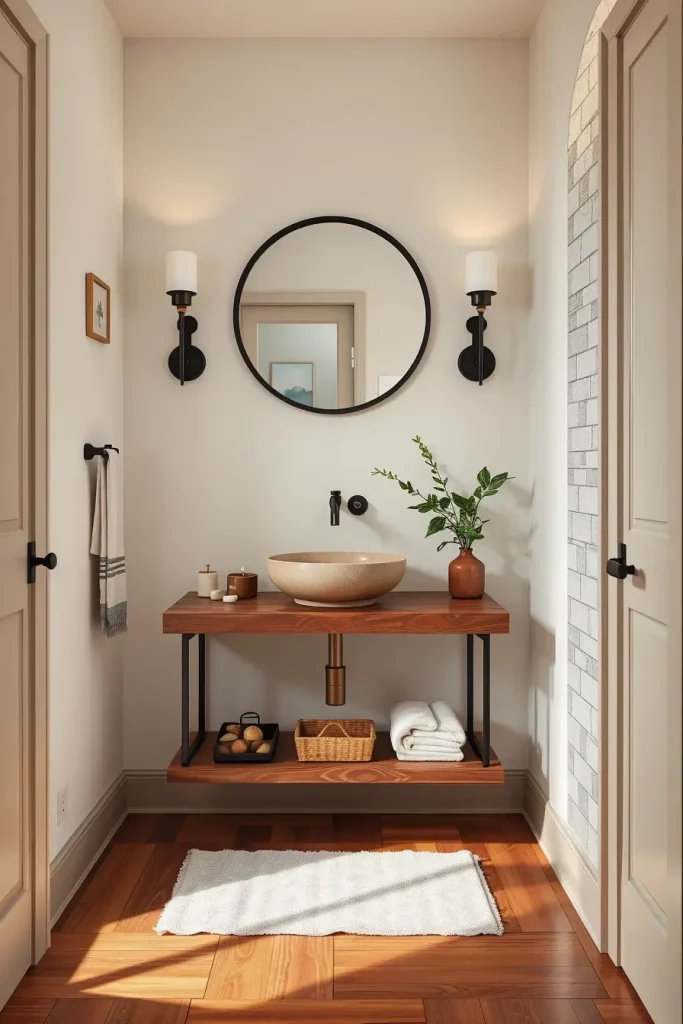
For me, it is here that guests are most aware of the special things about the event. I’ve played with different types of wall coverings in my Japandi powder rooms such as bamboo, matte tile or microcement. Experts say at Dwell that adding natural finishes to small spaces helps tie the design together and gives it a refined appearance.
Another way to make this space better is to include a mild air freshener and some soft towels made from woven linen or organic cotton. The remaining touches finish the room and show the Japandi focus on harmony and thoughtfulness.
Budget-Friendly Japandi Bathroom Makeover Ideas
A Japandi bathroom remodel can be done without spending a lot of money. I concentrate on important updates, like clearing clutter, choosing neutral colors and making sure things work well, when my clients ask for thrifty changes. Simple home changes and Do-It-Yourself touches can reflect the Japandi style which aims for warmth, elegance and peace.
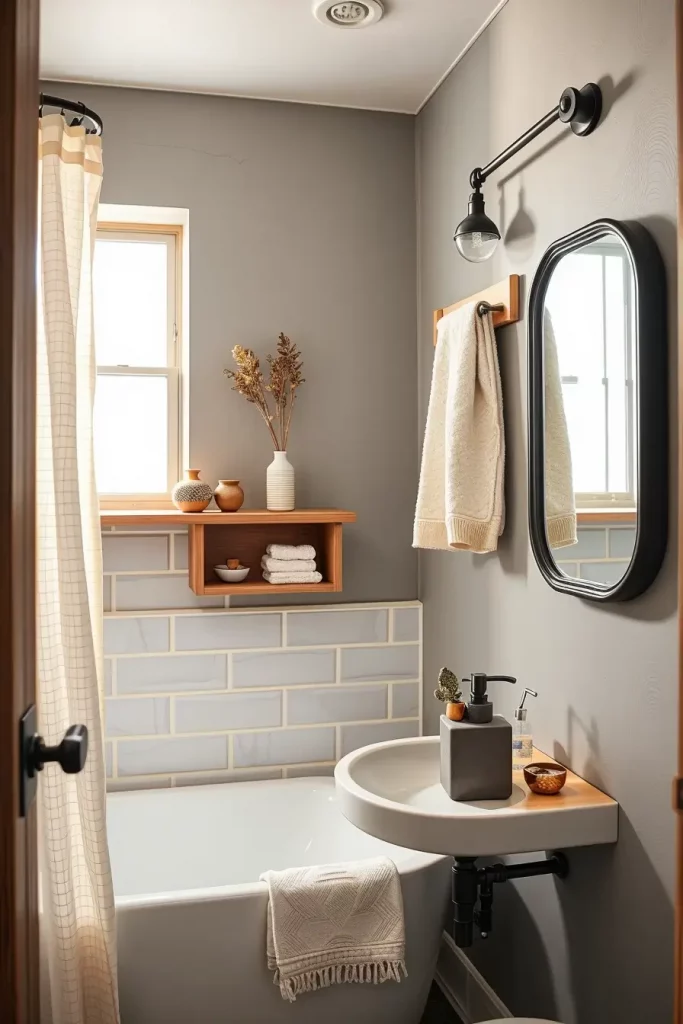
A simple first step is to update the paint with gentle neutral tones such as beige, warm grey or white. After that, use matte black or brushed brass for the hardware. Try making a storage shelf in light wood yourself for a bathroom update and switch the original mirror for a sleek, simple one without a frame. You can easily bring Japandi into your bathroom with linen shower curtains, wooden bath mats and concrete soap dispensers.
When making a tight budget bathroom renovation, keeping the look and finish the same throughout the room helps a lot. I’ve discovered that buying only one key piece such as a mirror or a wood vanity and using a handful of simple accessories is one of Real Simple magazine’s best ideas.
The one thing I would fix in most budget Japandi projects is the lighting. A soft matte finish on budget wall sconces or pendant lights can still make a big difference to your room. Don’t forget about lighting because it can completely change the feel of the space.
Japandi Bathroom Trends For Modern Homes
It seems that the newest Japandi bathroom trends focus on merging wellness and design together. Today’s bathrooms use warm colors, soothing elements and inspiration from nature. People want bathrooms that help them relax and focus and Japandi design meets that need.
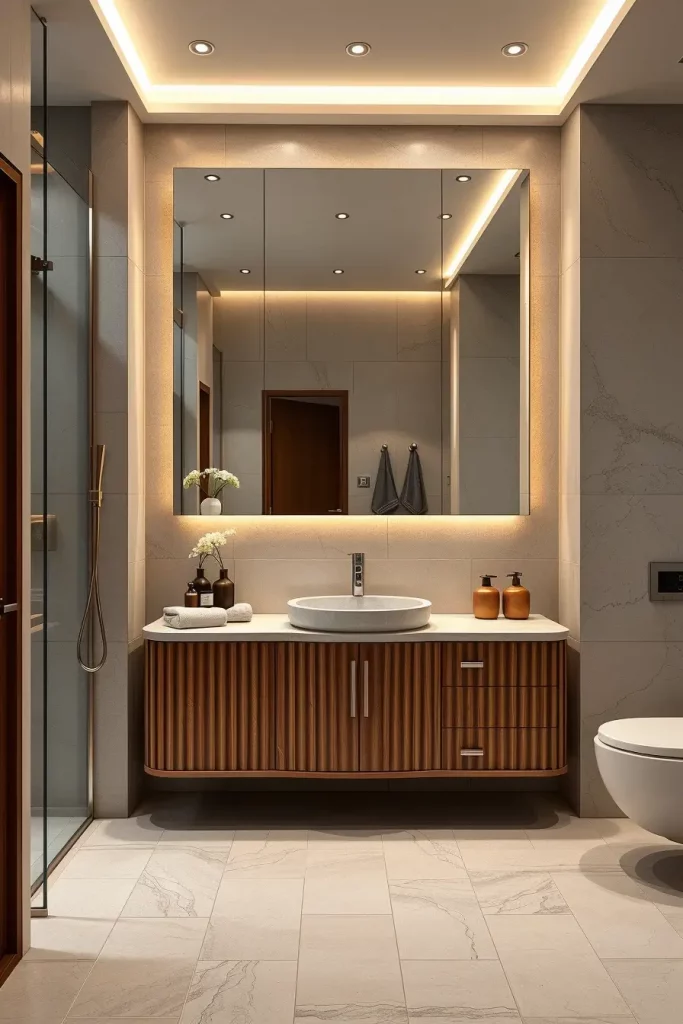
More people are choosing fluted wood vanities, storage that is open and has clean lines and sinks made from natural stone. They are made with large mirrors without any frame or with a thin black border. Walls are finished with plaster textures or wood and floors use large porcelain tiles in warm grays or soft taupes. The design is focusing on softness and tranquil visuals. New technologies such as using touchless faucets or LED lights, are now part of the design without spoiling the look.

I really enjoy that these trends are becoming more available to everyone. Now, having a minimal home is about being selective and cozy. Elle Decor explains that Japandi style comes from a “mindful modern” idea and this is very fitting for our hectic lives.
The one item I would add to the list is integrated seating or stools made of wood that serve as decoration too. These items add to the usefulness of the room and give the relaxing spa atmosphere we want.
Finishing Touches That Elevate Japandi Elegance
Japandi elegance is mostly achieved by paying attention to the small details in the design. Working on projects, I mostly focus on making sure the room looks balanced with natural decor, clear layout and careful attention to detail. Accessories, textiles and scents are what convert a room from being plain to peaceful and calm.
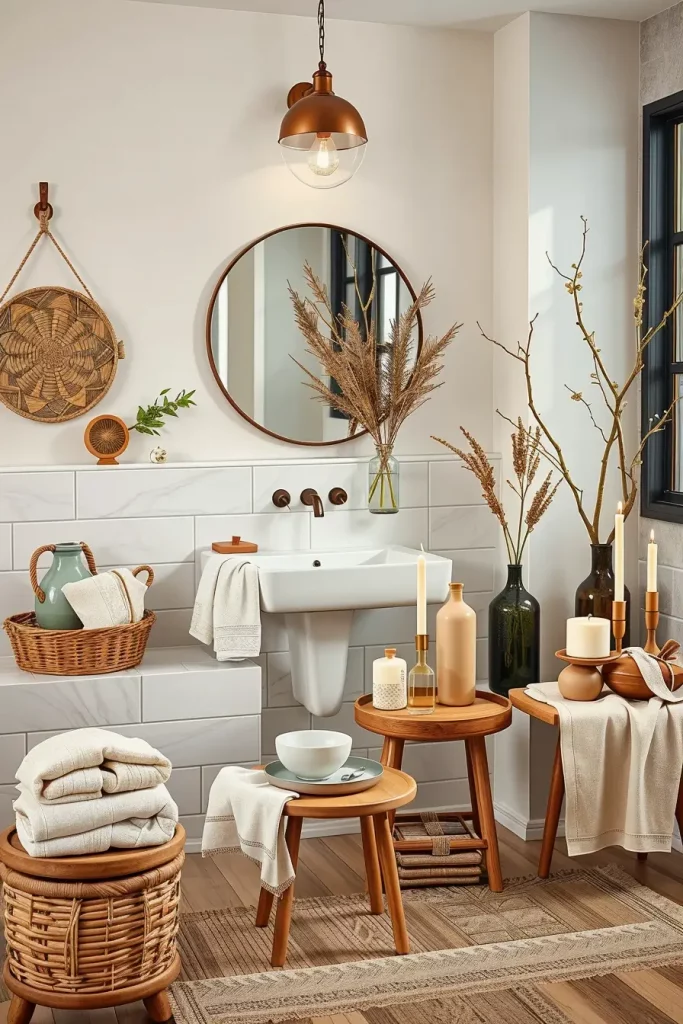
Some of the final decorations I like to use are woven baskets, amber glass bottles and handmade pottery trays. I hang soft linen or waffle-weave towels in soft tones in the bathroom and I also put a teak or bamboo bench or stool next to the shower. Using a handmade soap dish or adding a dried branch to a vase are ways to include some artistic charm.
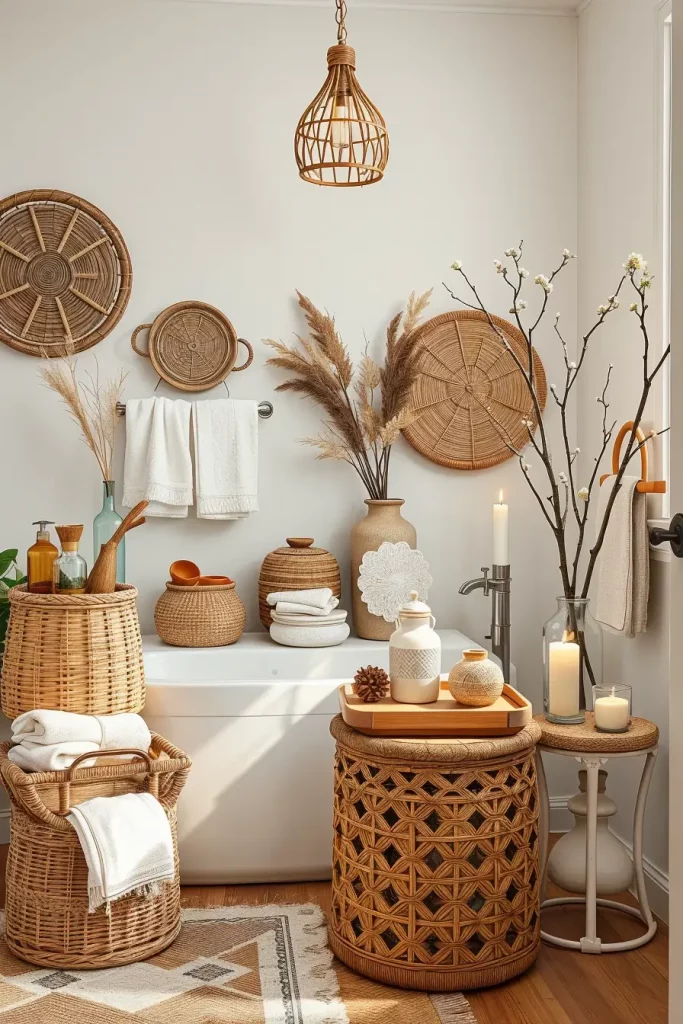
Using woody or herbal diffusers or soy candles has been a way for me to enhance the feel of any room. Domino Magazine regularly points out that including one organic element—driftwood or river stones—can give the space a strong base and represent the nature focus in Japanese and Scandinavian design.
To add one last tip, try adding texture in different areas of the room. Even if you prefer neutral tones, mixing wood, linen, ceramic and stone can add texture to your room. The Japandi style isn’t about putting in too much detail, but about finding true simplicity.
Whether you’re planning a full renovation or simply updating a few elements, Japandi-style bathrooms offer a timeless blend of simplicity, warmth, and functionality. I wish that these ideas help you create a place that is quiet, neat and linked to nature. If you’ve tried any of these designs or have your own Japandi-inspired tips, I’d love to hear from you—feel free to share your thoughts in the comments below!
